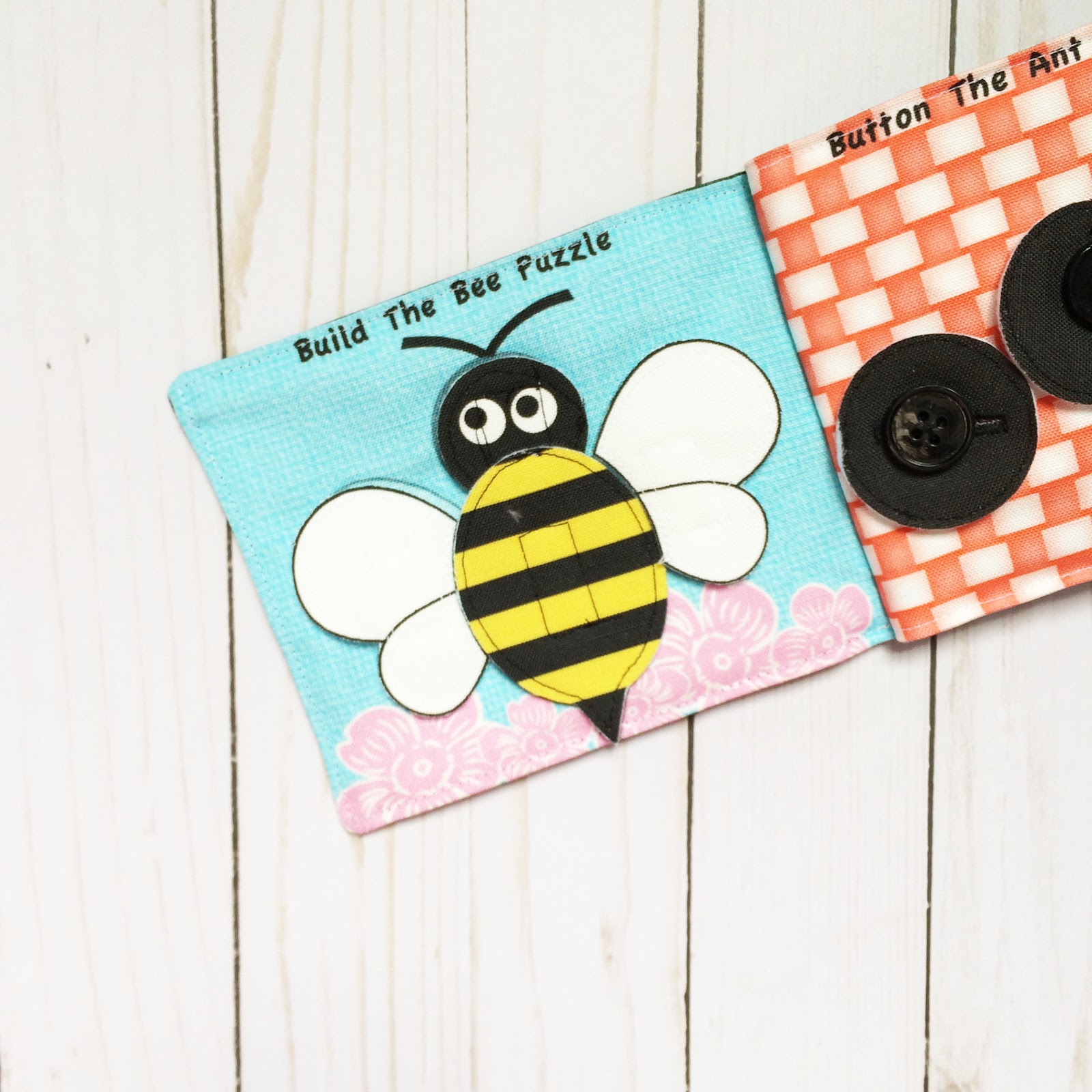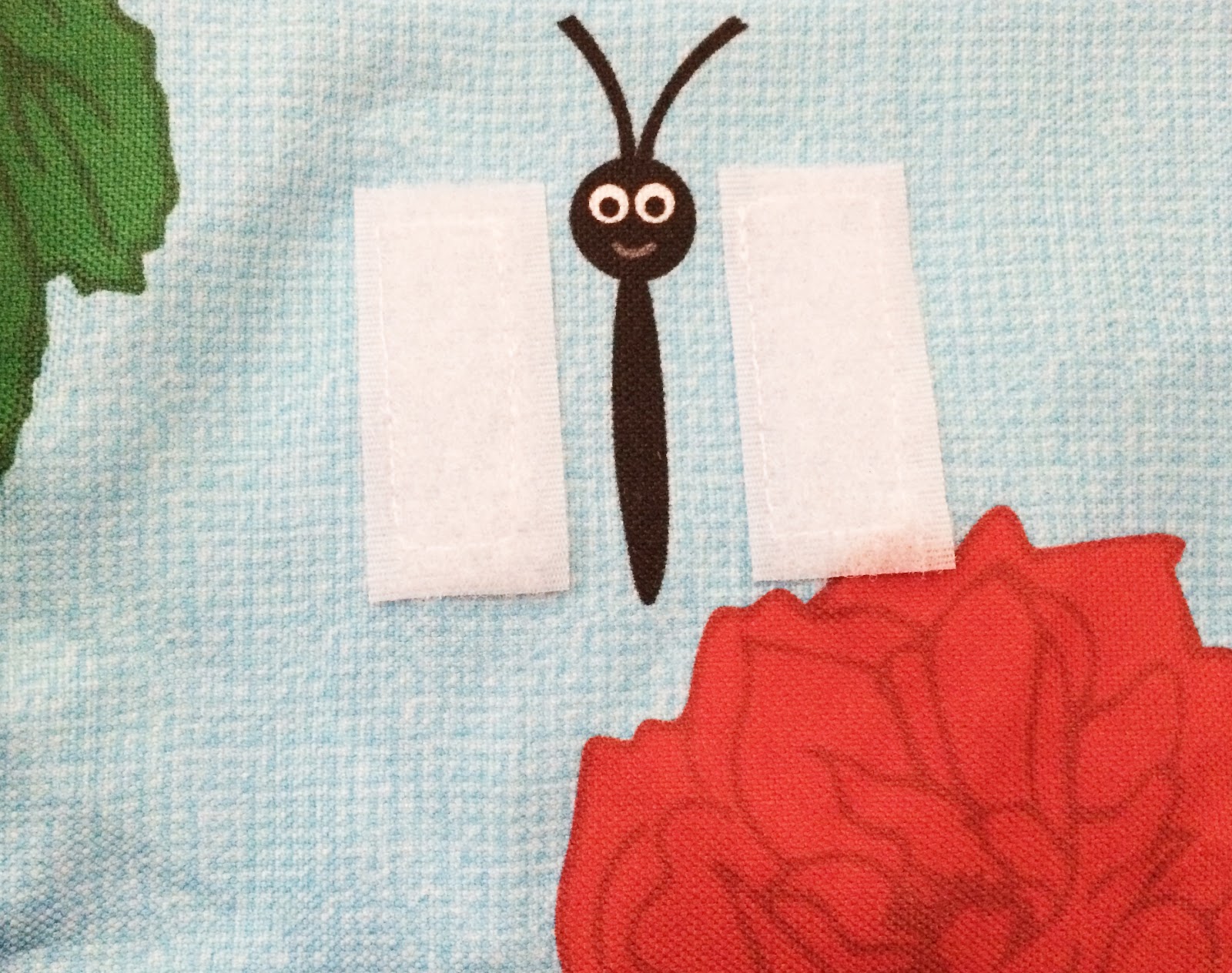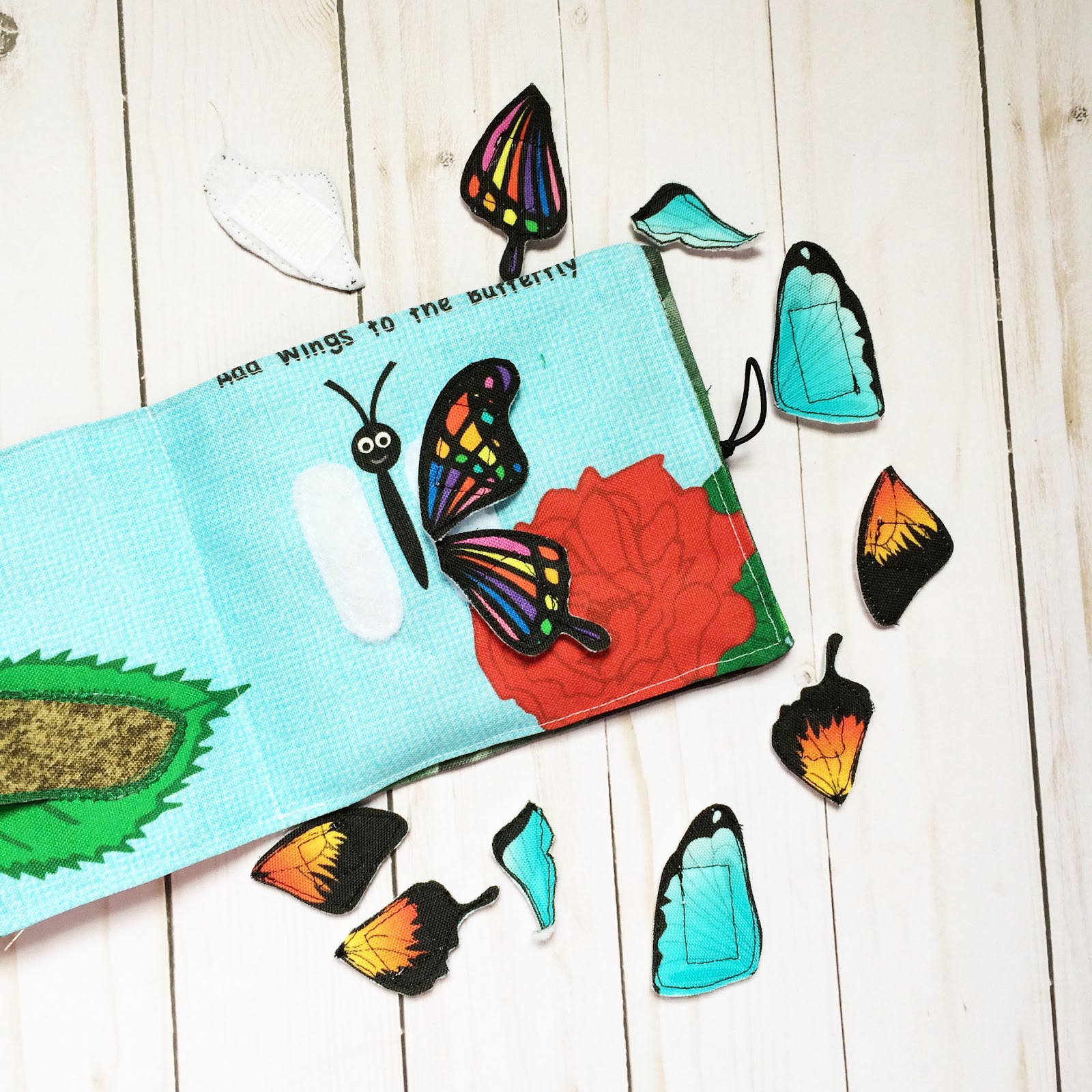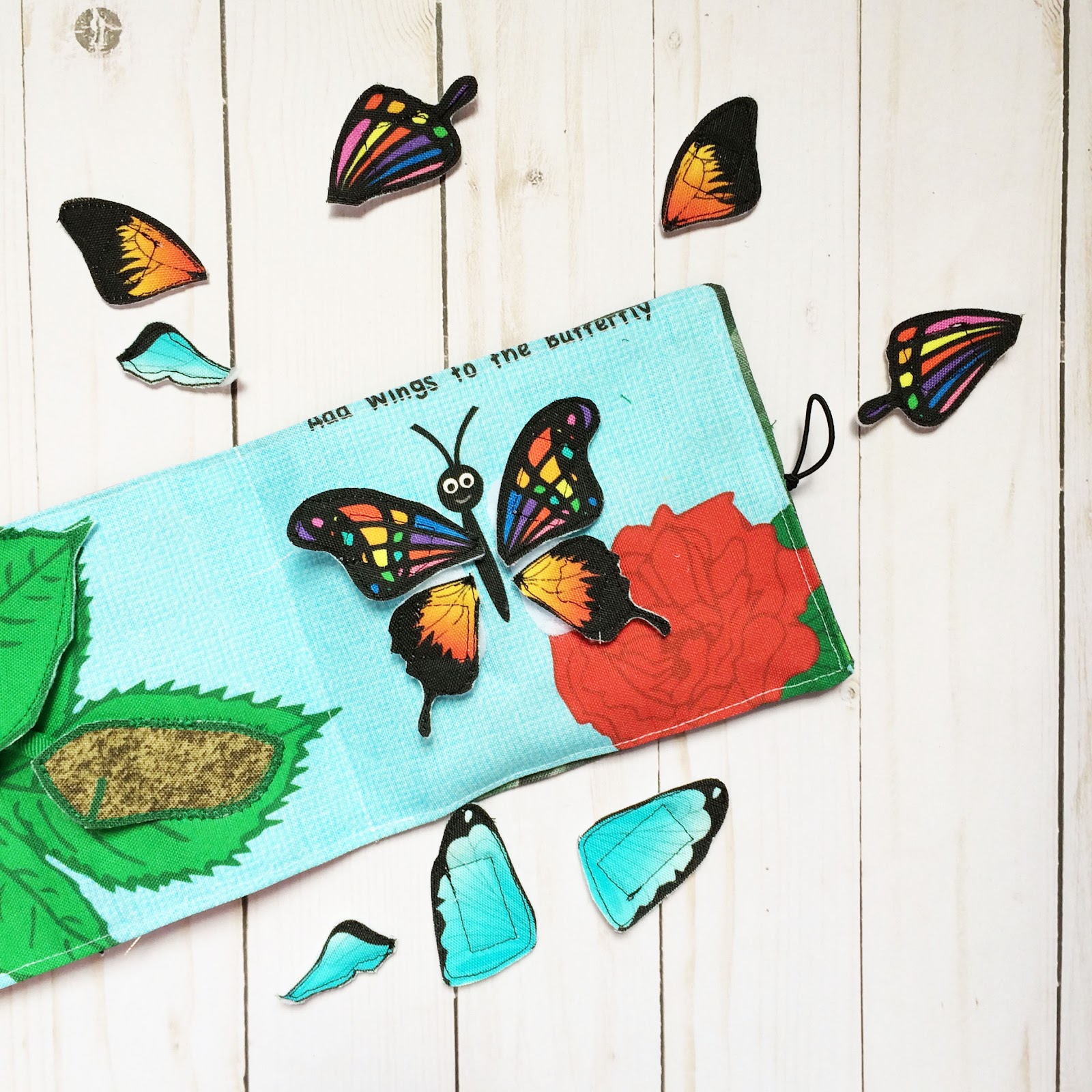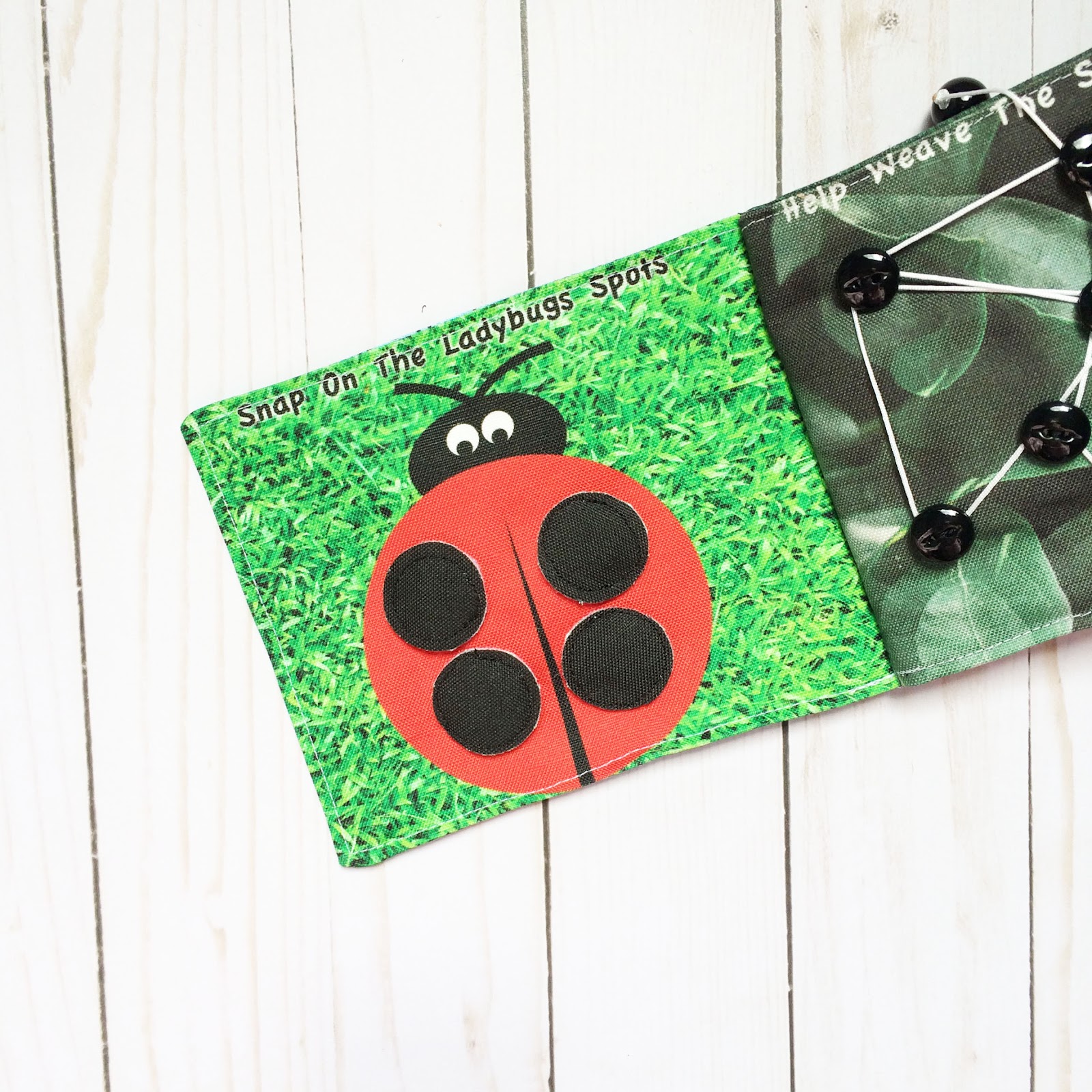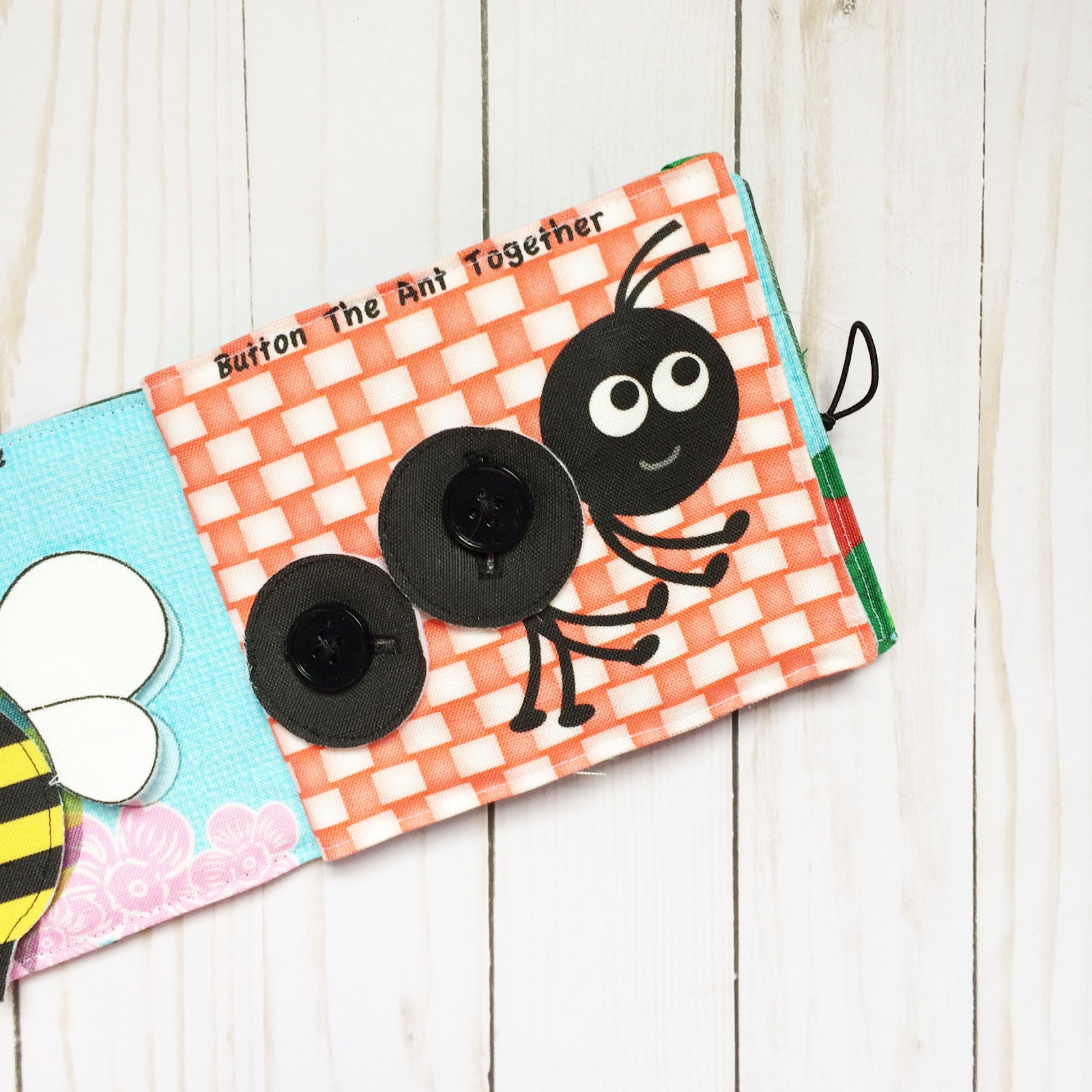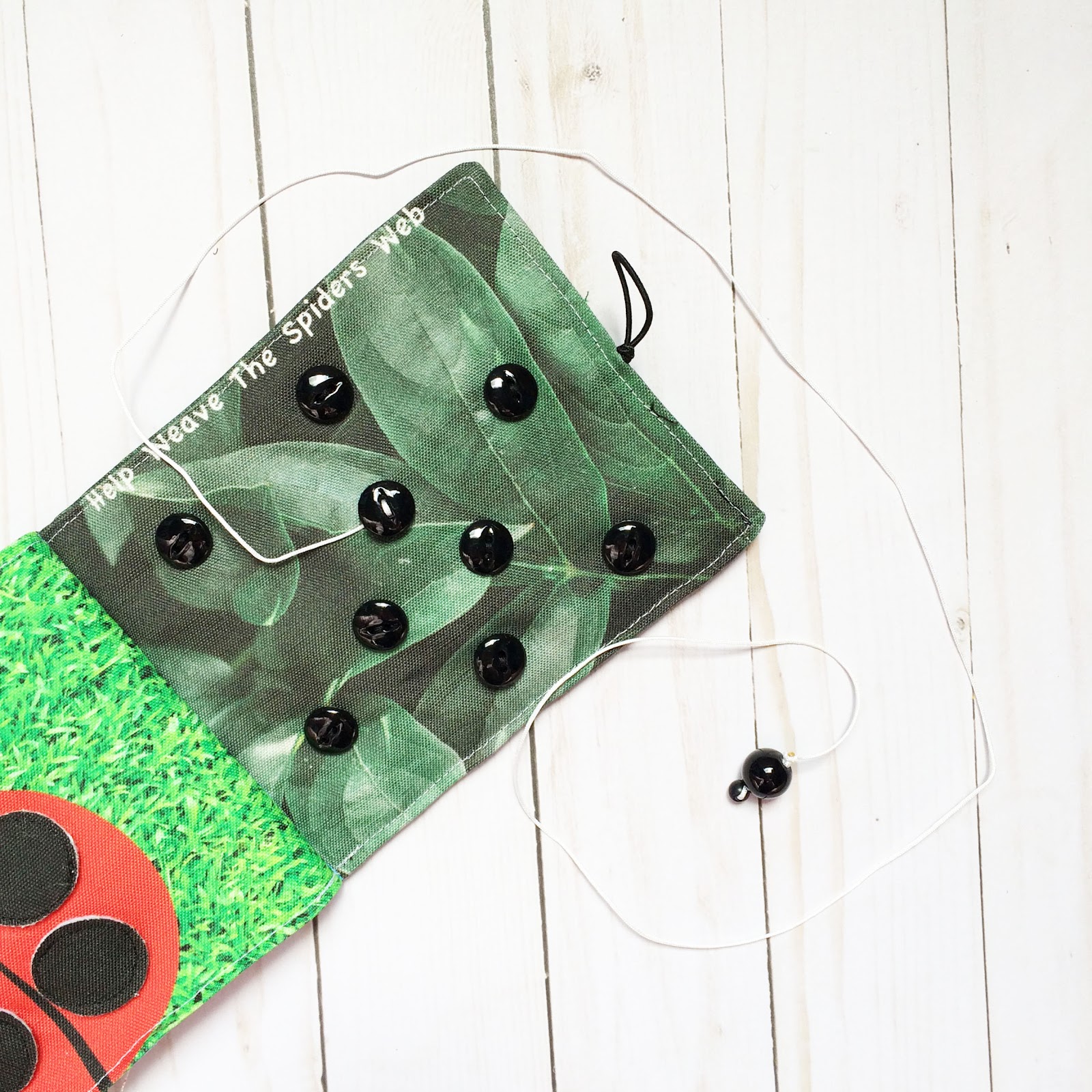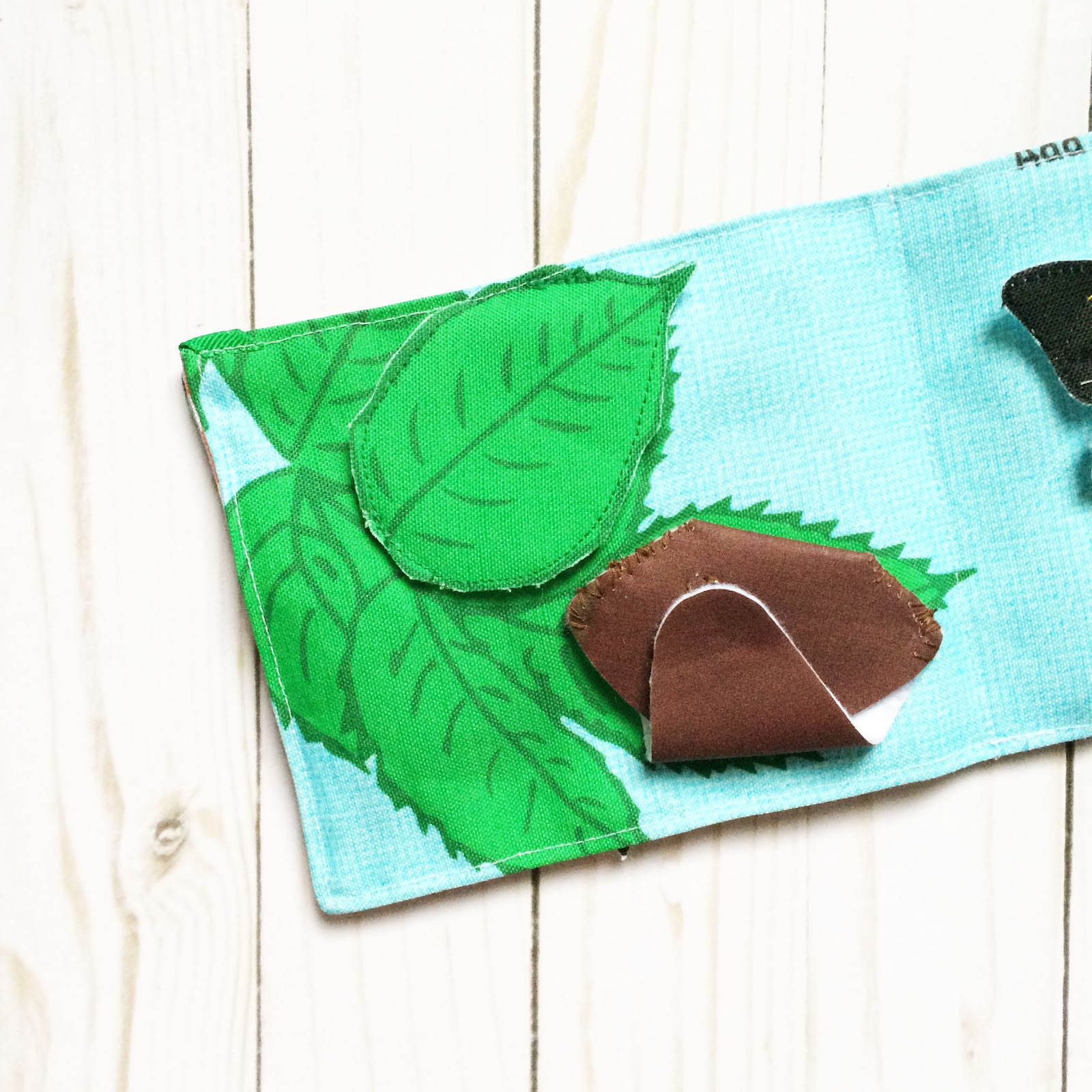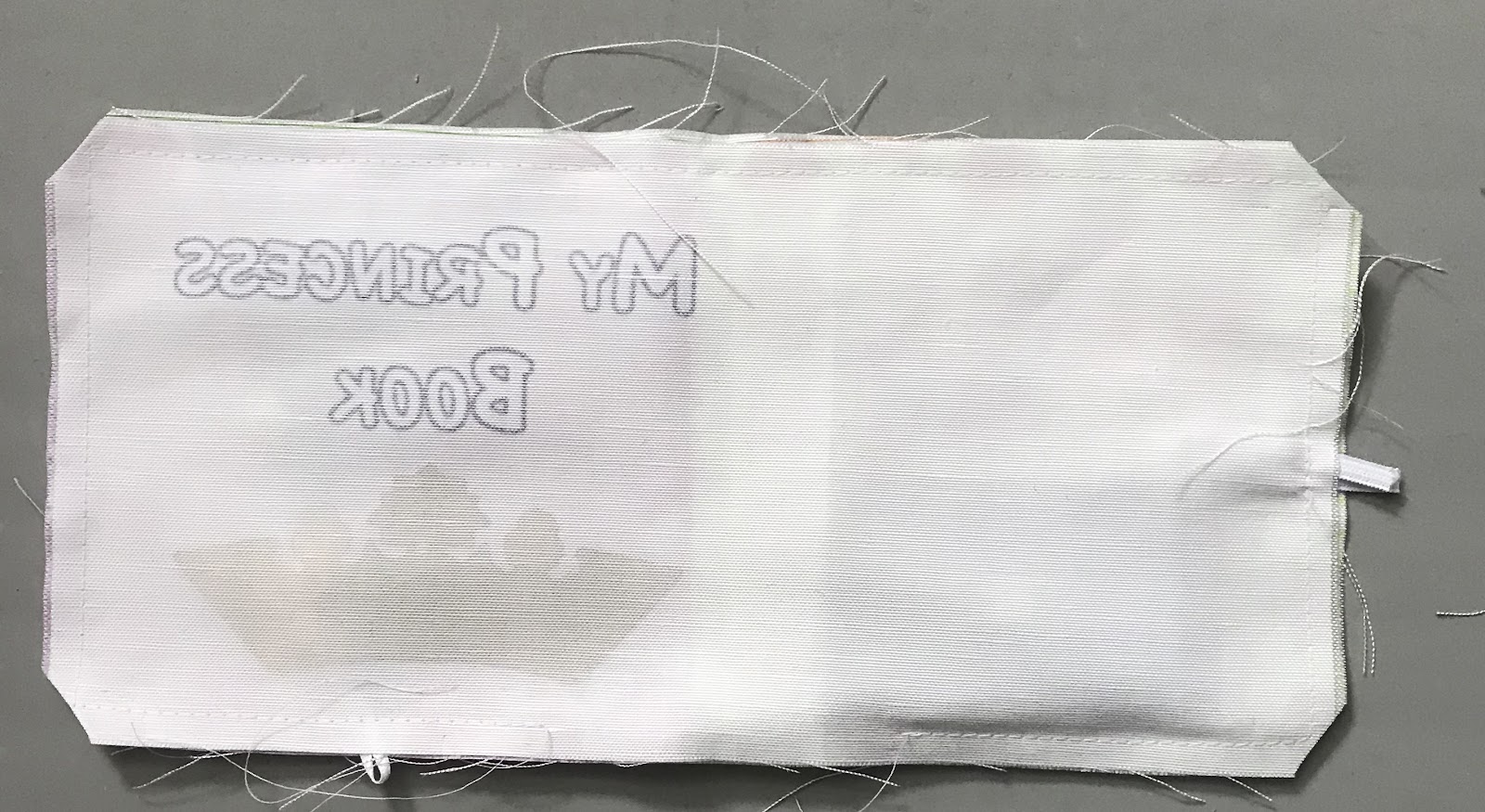This post may contain affiliate links. Read our disclosure policy.
Click here to purchase this fabric through Spoonflower (I recommend the cotton canvas fabric for the best durability)
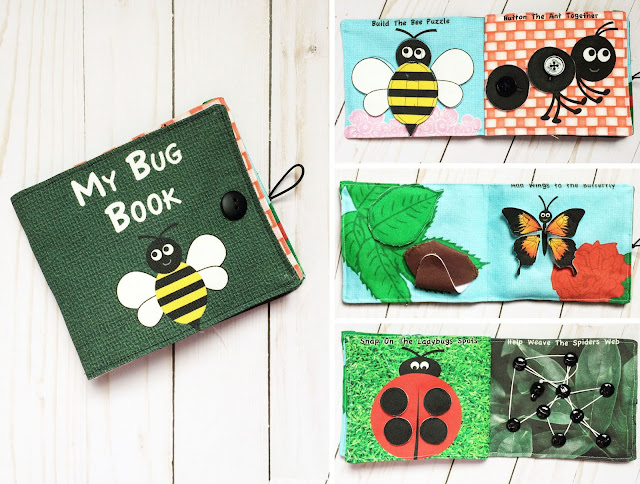
Anticipated Crafting Time for this project: 4-5 Hours
This busy book is recommended for children ages 3-5.
Warning – This book contains small parts that may present a choking hazard for children under the age of 3.
The “My Bug Book” includes instructions to make the following pages:
• A front cover for the book
• A “Build The Bee Puzzle” page, with a 4 piece Velcro bee puzzle.
• A “Button The Ant Together” page, with two button on circles.
• A caterpillar page, with a peek-a-boo leaf, a free form caterpillar, and a pocket cocoon with a hook and eyelet.
• An “Add Wings To The Butterfly” page, with Velcro strips and 12 possible Velcro on wing designs to add and move around.
• A “Snap On The Ladybug Spots” page, with four snap on black spots.
• A “Help Weave The Spider Web” page, with a beaded spider, nine buttons, and a long length of string that can be woven around the buttons. (Supervise young children with the long string)
• A back book cover with a pocket for holding excess pieces when the book is not in use.
You will need the following supplies:
• Printed fabric for the pages and pieces (Available for purchase through Spoonflower – I would recommend the cotton canvas fabric for the best durability)
• Iron on fixative lining (to reinforce the smaller pieces)
• Felt (to reinforce the smaller pieces)
• Cording
• Elastic
• Velcro
• 2 Black or Brown Beads (One smaller one larger for the spider body)
• 9 Small Buttons (for the spiders web)
• 2 Large Black Buttons (for the button on ant)
• 4 Sewable Snap
• A Hook and Eyelet Pair
• A Sewing Machine (Can also be hand sewn)
• A Needle
• Thread
• Sewing Pins
• Scissors
• An Iron
• An Ironing Board or Ironing Surface
• Note – A few minor design updates may have been made to the fabric & movable pieces for better usability.
Step One:
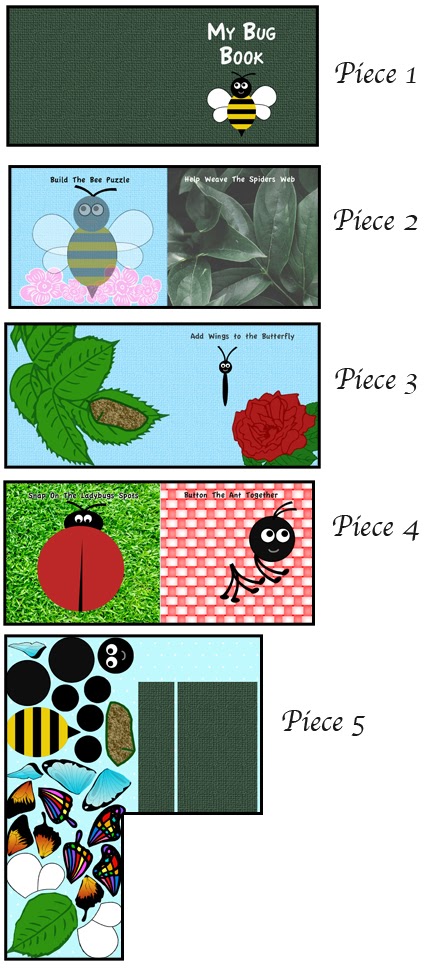 Iron the printed fabric. Then take the fabric and cut out the 4 large rectangular pages of the book, each section should have two pages still attached in the middle, and when they are cut out they should look like the image to the right.
Iron the printed fabric. Then take the fabric and cut out the 4 large rectangular pages of the book, each section should have two pages still attached in the middle, and when they are cut out they should look like the image to the right.
Put pages aside.
Step Two:
Take the leftover fabric with the various smaller pieces for the quiet book and make sure you DO NOT CUT OUT the individual pieces.
Take the smaller pieces, your fixative lining and your felt and follow the fixative instructions to glue the pieces to the felt for added stability.
Start by taking the fabric with the smaller quiet book pieces and cut the iron on fixative lining and the felt to match the size and shape of the fabric.
Next layer them with the felt on the bottom, the iron on fixative in the middle, and the fabric on top (with the printed side facing away from the fixative). You may want a disposable cloth, or bit a excess fabric for this part as any overhang of the iron on fixative will be sticky and will gunk up your iron or ironing board if they touch.
Set your iron to a medium setting and press it to the printed fabric holding it for three seconds before removing it and pressing the next section. Continue until the whole cloth has been ironed. Then flip your cloth over so the print side is down, and repeat the process. (again you may want to use a cloth on this part to save your fabric and your iron if you have any overhang).
Step Three:
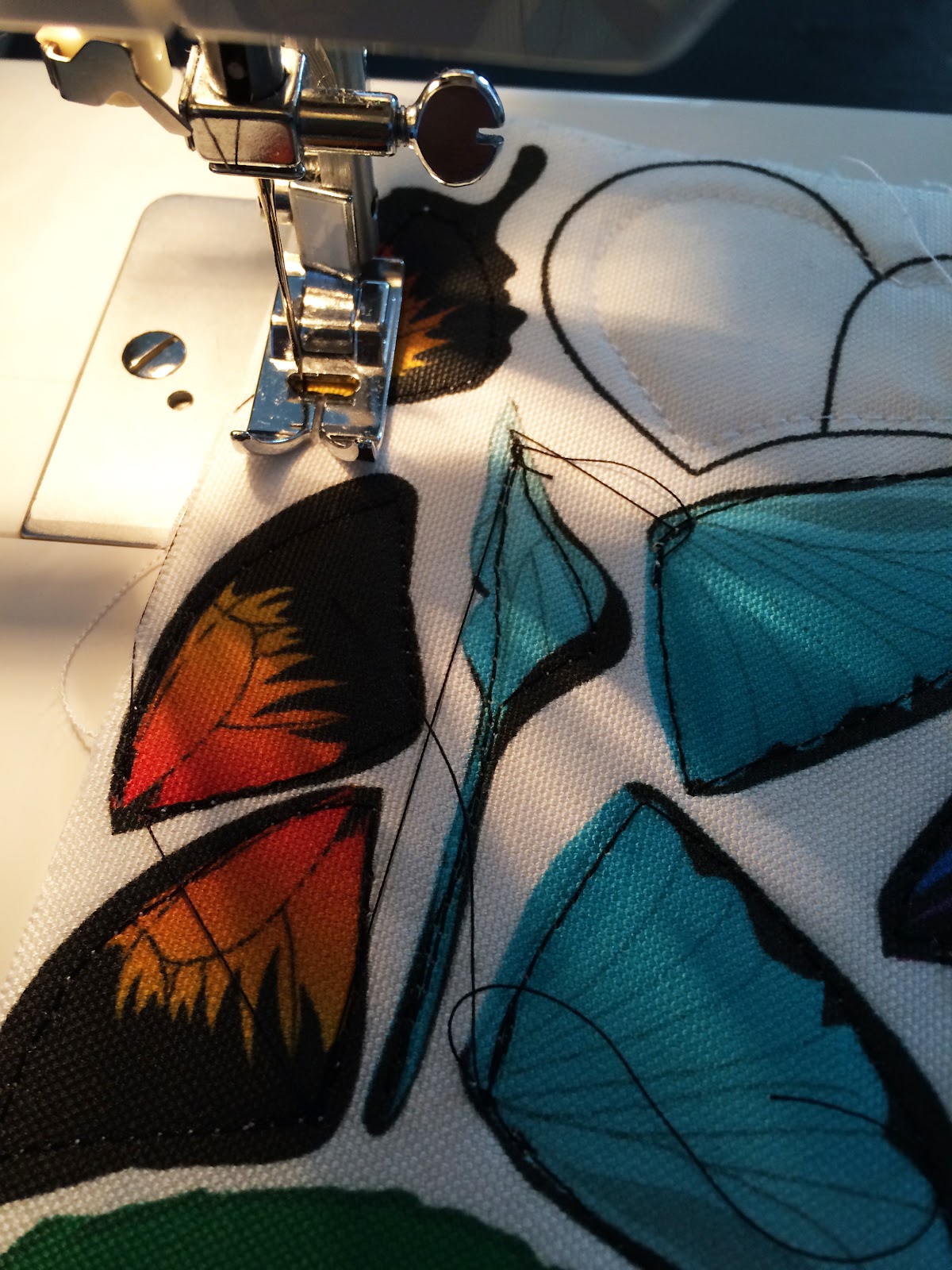 Take the fabric with the various quiet book pieces to your sewing machine and sew around each individual piece, keeping your thread just barely inside the line of the design.
Take the fabric with the various quiet book pieces to your sewing machine and sew around each individual piece, keeping your thread just barely inside the line of the design.
Step Four:
After sewing around each of the butterfly wings and pieces for the “Bee Puzzle” take a piece of velcro and cut strips of it sized for each of the pieces. Sew the rough part of the velcro to the back of each butterfly wing and “bee” piece.
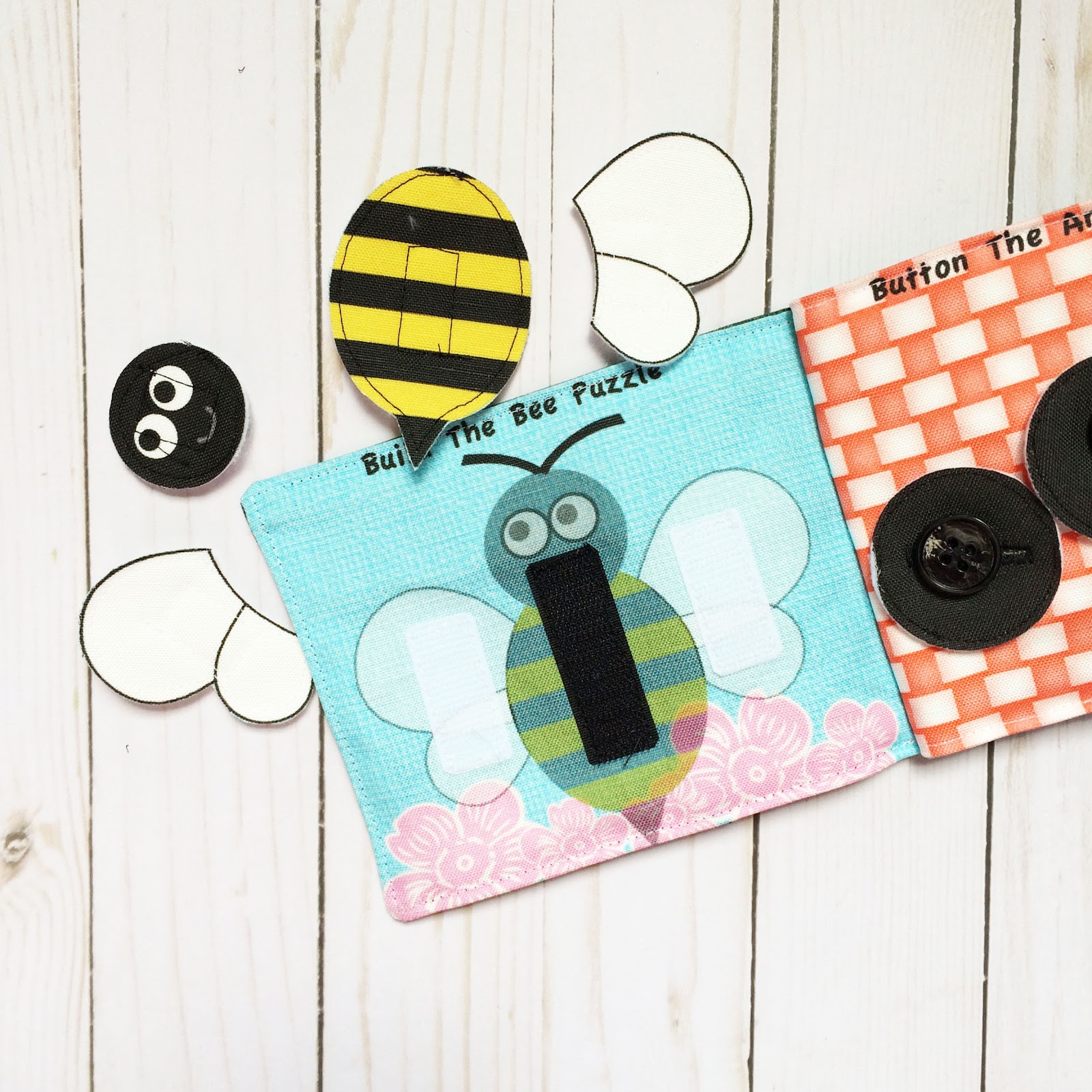
Step Five:
Find the Quiet Book page titled “Build The Bee Puzzle” and sew the soft part of the velcro to the middle of each wing, and a long strip from the bee’s head down its body like shown in the image above.
Step Six:
Find the Quiet Book page titled “Add Wings To The Butterfly” and sew a strip of the soft side of the velcro to each side of the butterfly’s body like in the image shown below.
Step Seven:
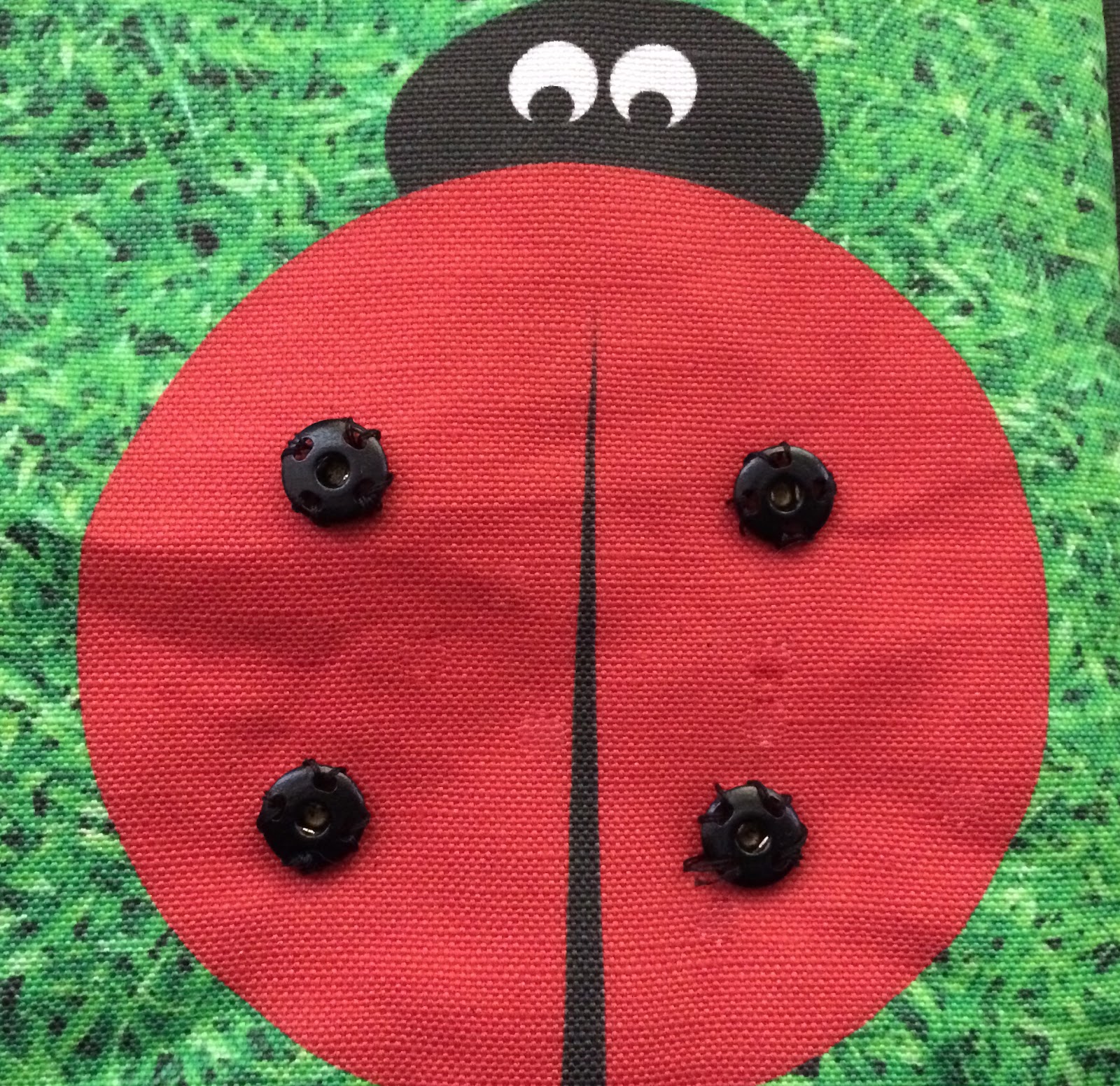 Separate your snaps, and hand sew one side of the backing on each of the four, small and matching in size, black circles (Ladybug Spots). (Note: Make sure you sew the correct or snappable side of the snap facing out – test with the other half of the snap to see if they fit together if you are unsure which side is correct).
Separate your snaps, and hand sew one side of the backing on each of the four, small and matching in size, black circles (Ladybug Spots). (Note: Make sure you sew the correct or snappable side of the snap facing out – test with the other half of the snap to see if they fit together if you are unsure which side is correct).
Step Eight:
Take the page with the title “Snap On The Ladybug Spots”. Hand sew the other side of the snaps used in step seven to the red part of the ladybug’s body. (Note: Make sure you sew the correct or snappable side of the snap facing out – test with the other half of the snap to see if they fit together if you are unsure which side is correct)
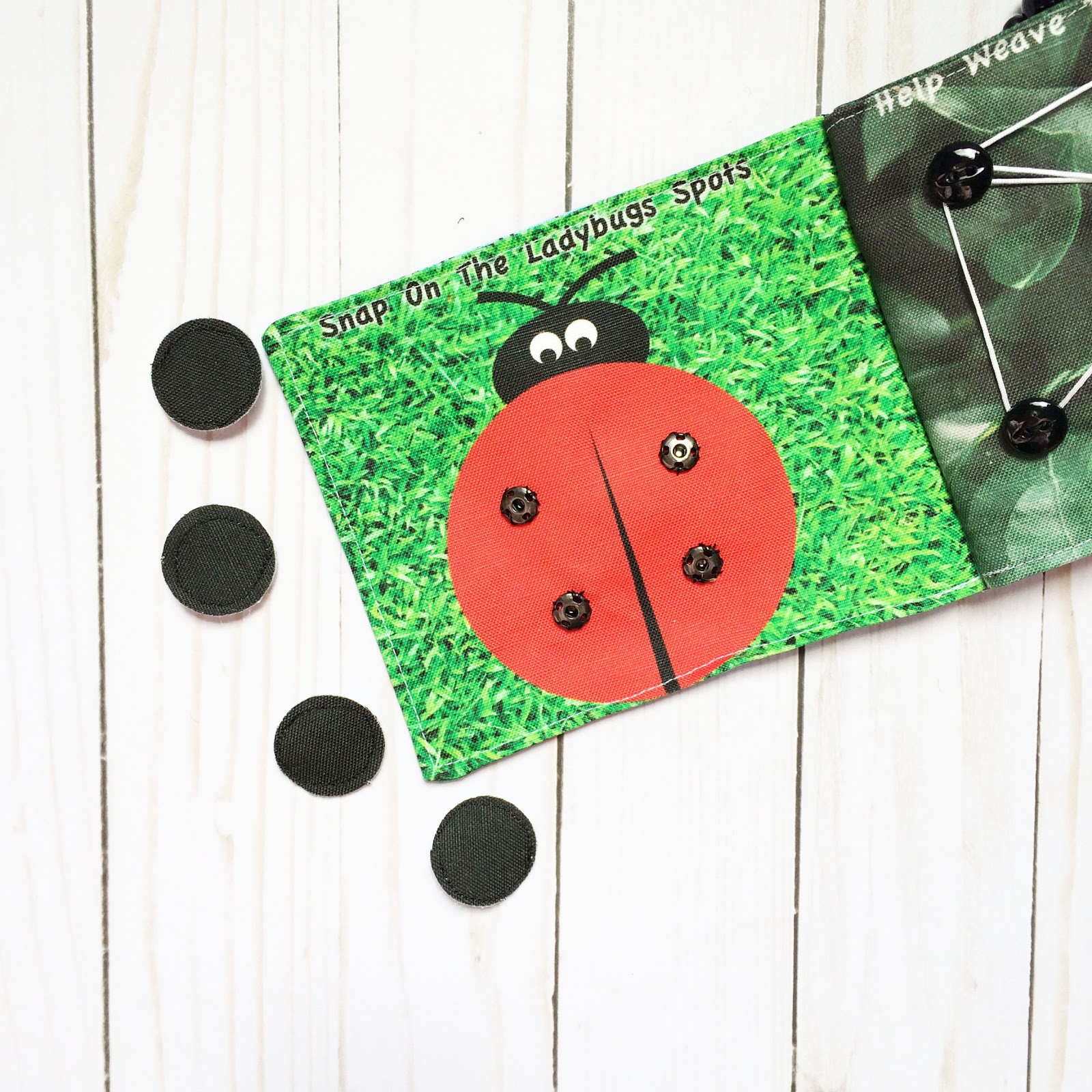
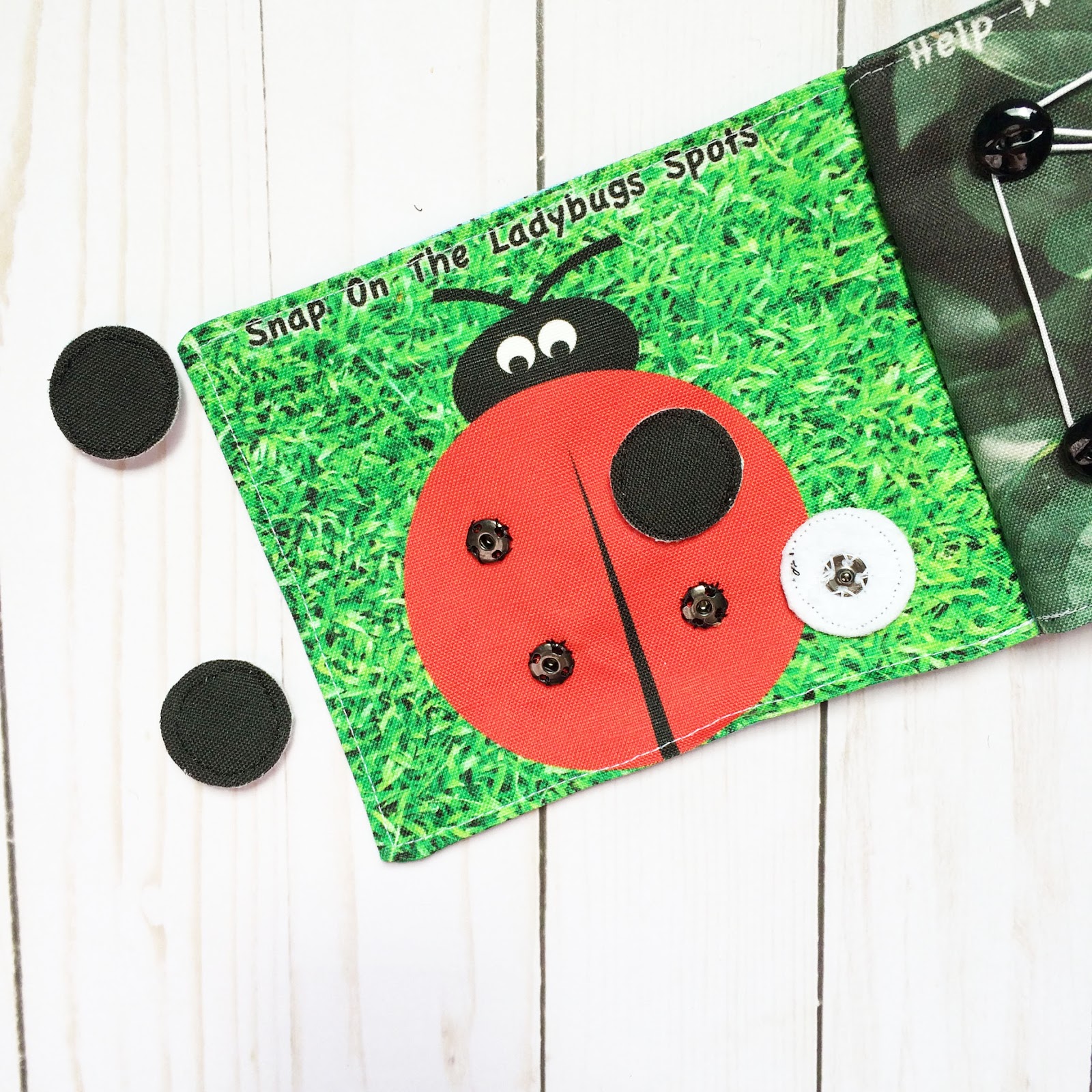
Step Nine:
Step Ten:
Step Eleven:
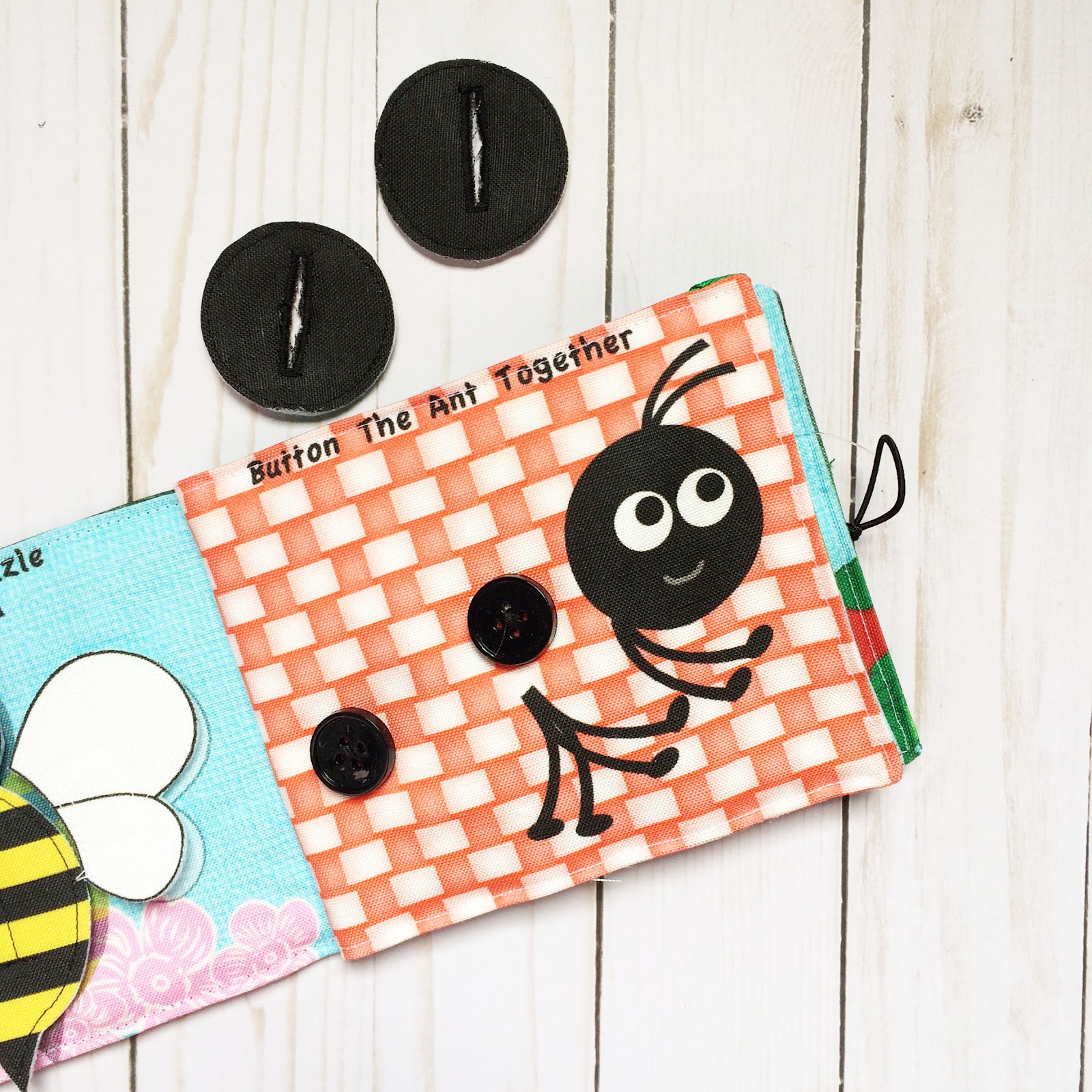
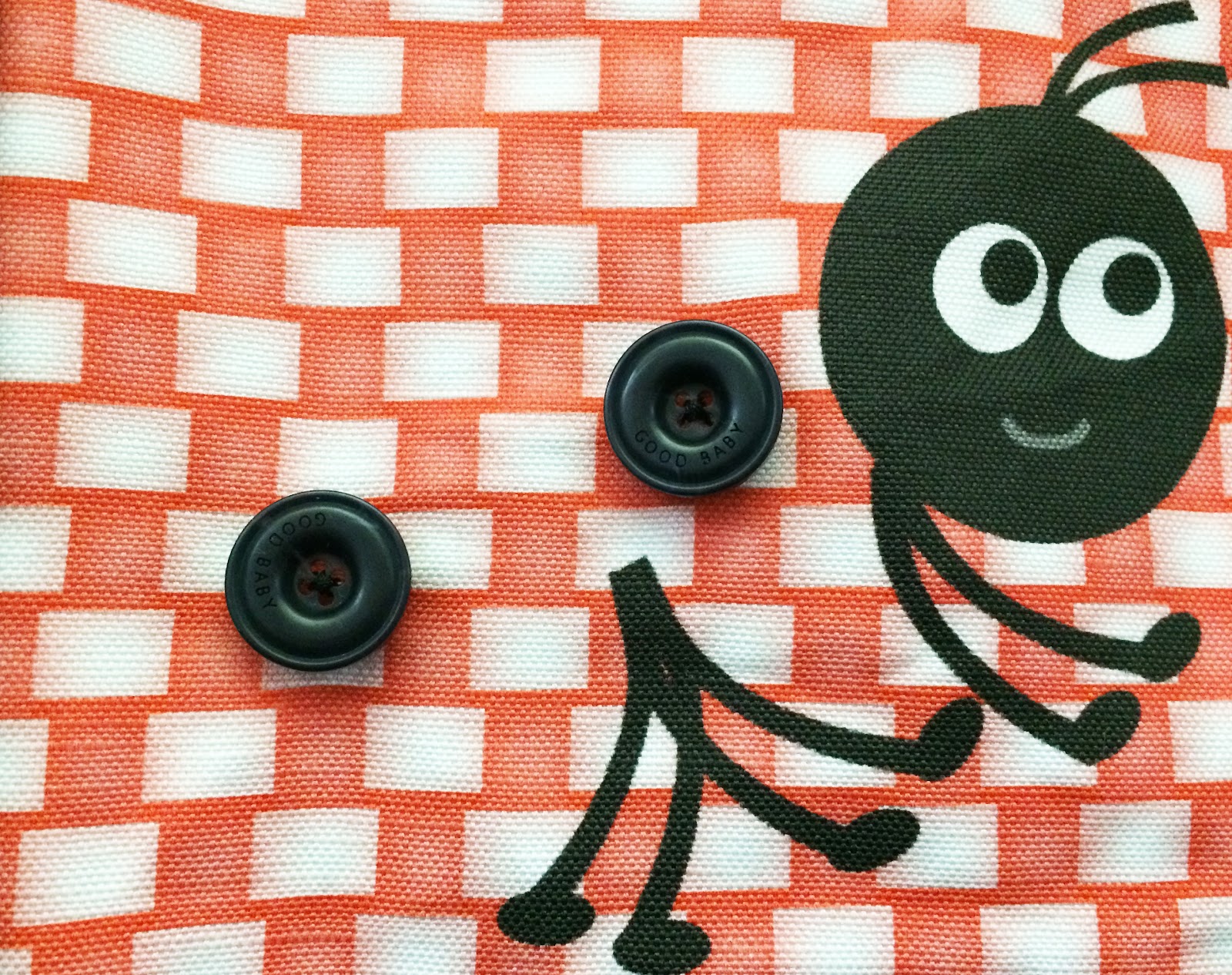
Step Twelve:
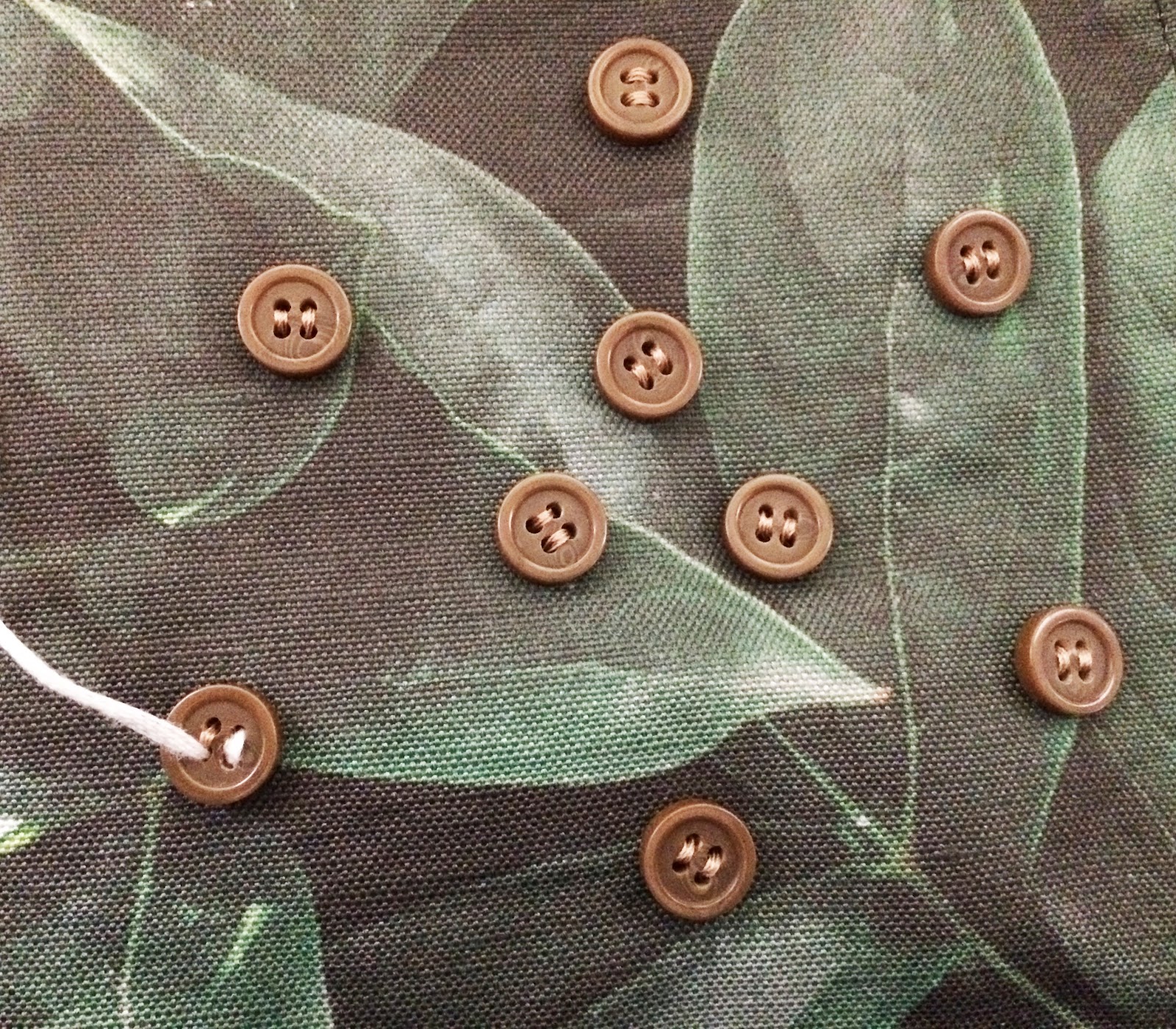 Find the page titled “Help Weave The Spider’s Web”. Take your nine small buttons and lay them out over the page in a circle type pattern, and hand sew them into place. I suggest making a small triangle in the middle with three buttons and then sewing the other six around the triangle in a bigger circle like in the image to the right. I would also suggest having each of your buttons sewn ¾ of an inch to 1 ½ inches apart. Make sure you leave a 1 ½ inch margin from the top, right, and left of the page so the buttons don’t get sewn when attaching the pages together.
Find the page titled “Help Weave The Spider’s Web”. Take your nine small buttons and lay them out over the page in a circle type pattern, and hand sew them into place. I suggest making a small triangle in the middle with three buttons and then sewing the other six around the triangle in a bigger circle like in the image to the right. I would also suggest having each of your buttons sewn ¾ of an inch to 1 ½ inches apart. Make sure you leave a 1 ½ inch margin from the top, right, and left of the page so the buttons don’t get sewn when attaching the pages together.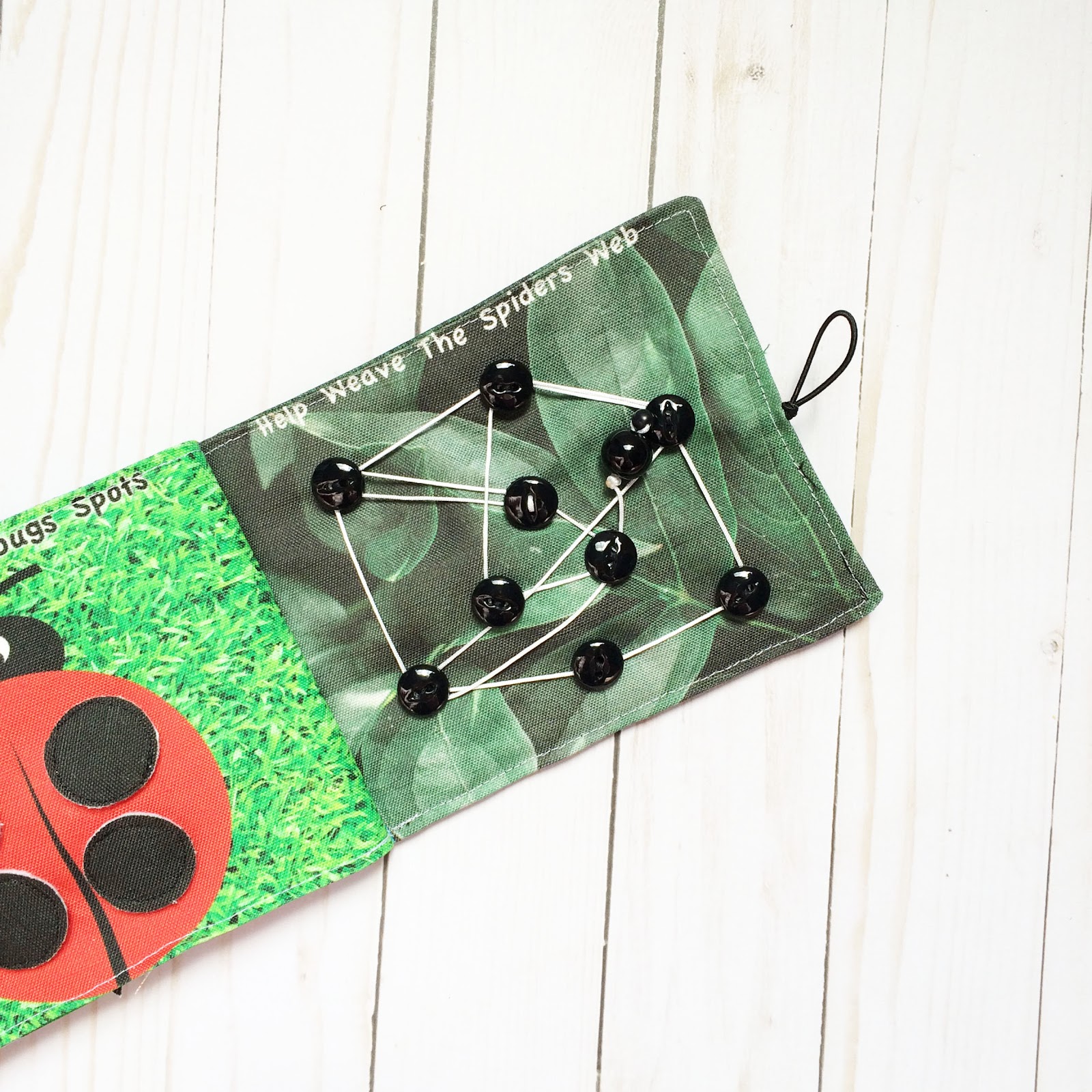
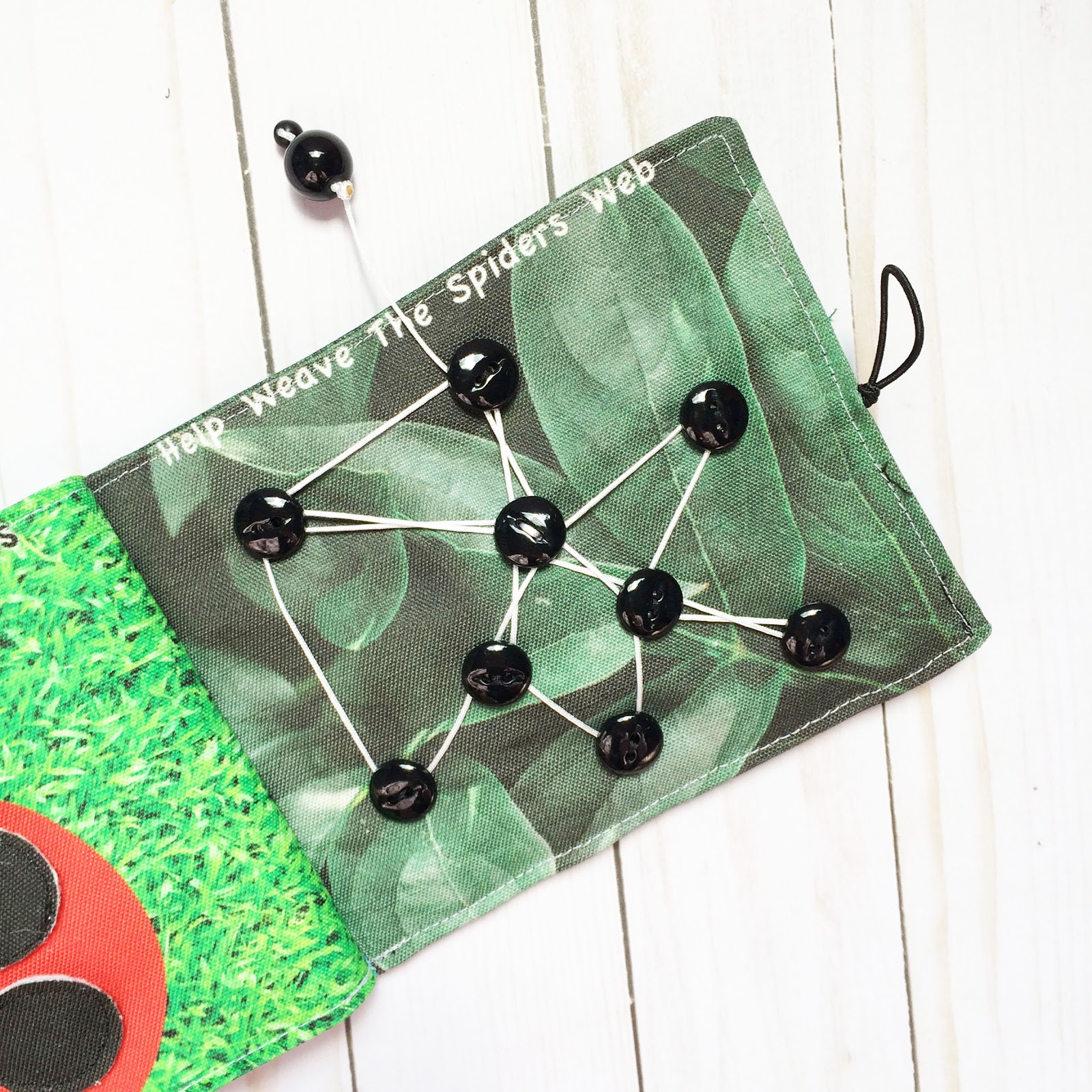
Step Thirteen:
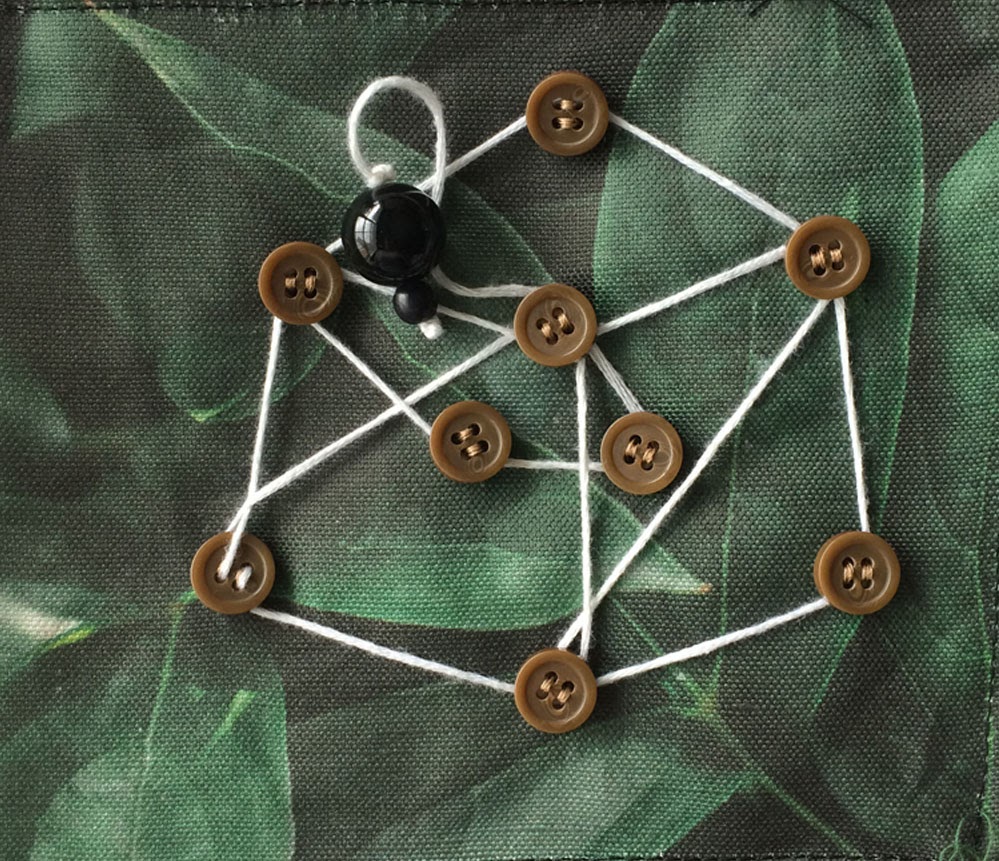 Take a long string and starting from the back of the spider page knot it into place. Then using a needle thread the long piece through one of the buttonholes.
Take a long string and starting from the back of the spider page knot it into place. Then using a needle thread the long piece through one of the buttonholes.
Next, thread the larger of your two spider beads onto the thread followed by the smaller of the two beads. Then loop the thread back through just the bottom/larger bead. Knot your thread (I suggest multiple times) under the large black bead so that the two beads are at the far end of the string. Cut off any excess hanging thread.
Step Fourteen:
Take the large green leaf cutout and match it up with the large green leaf on the caterpillar page. Sew the leaf into place by sewing a short line across the top of the leaf (where it might connect to a branch) creating a leaf “flap”.
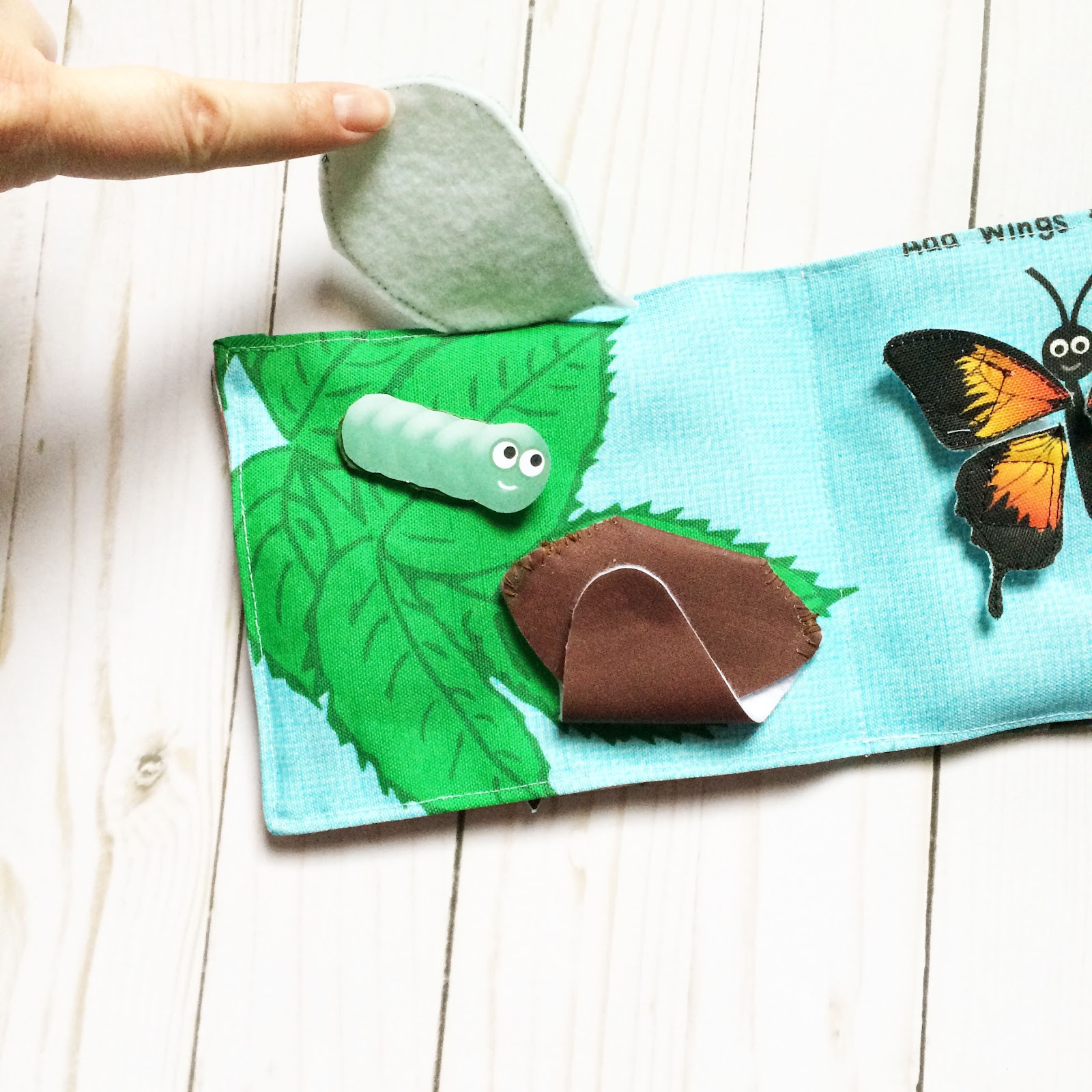
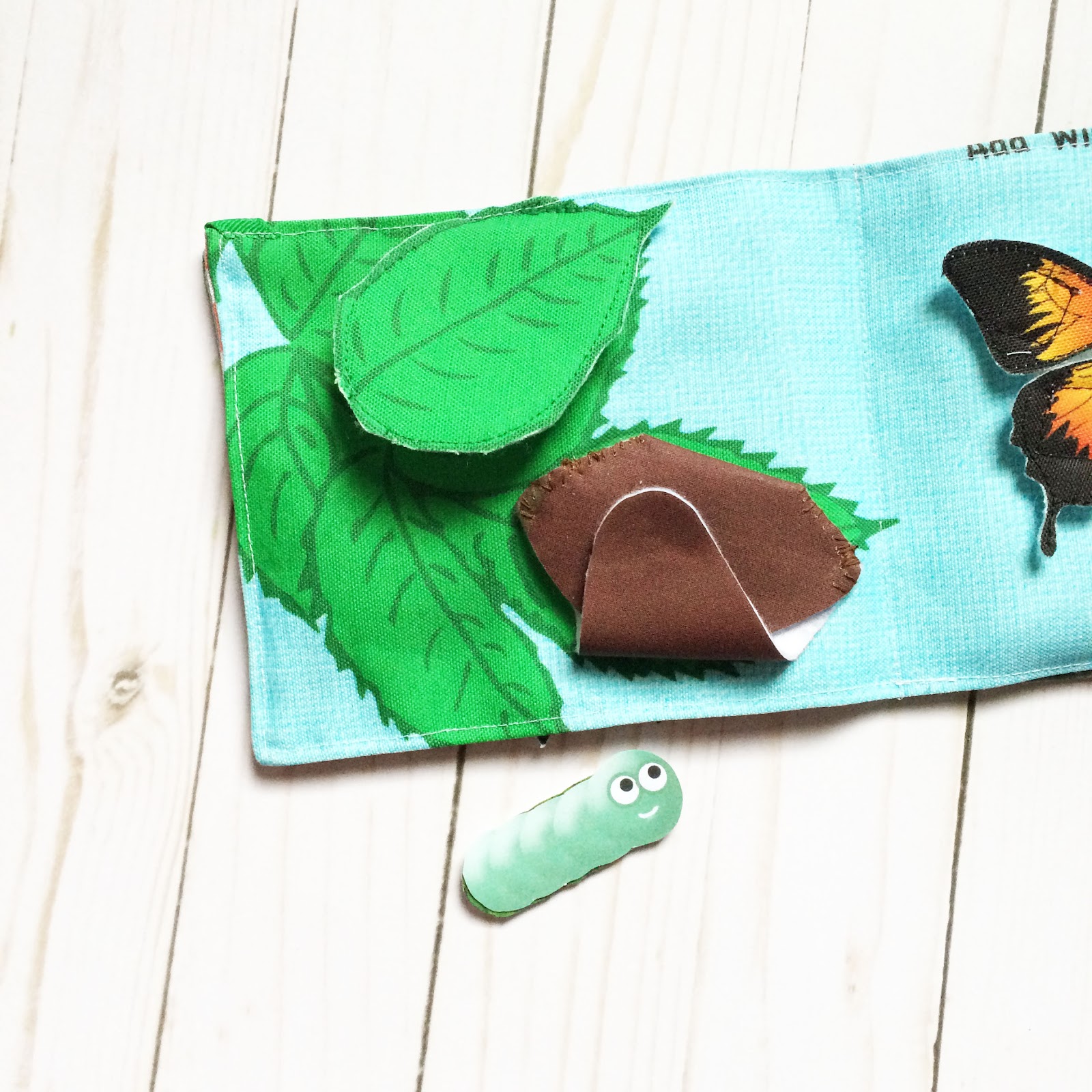
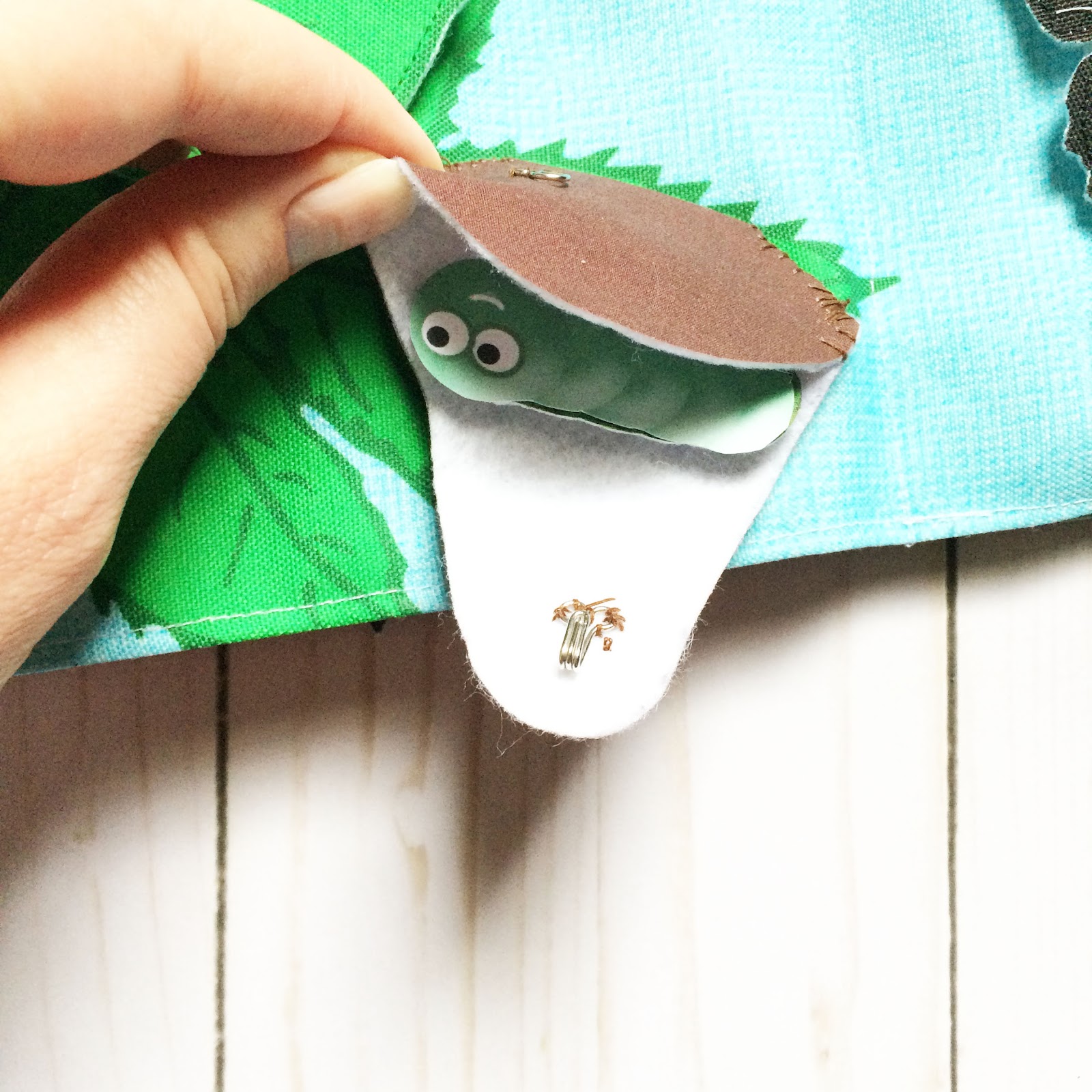
Step Fifteen:
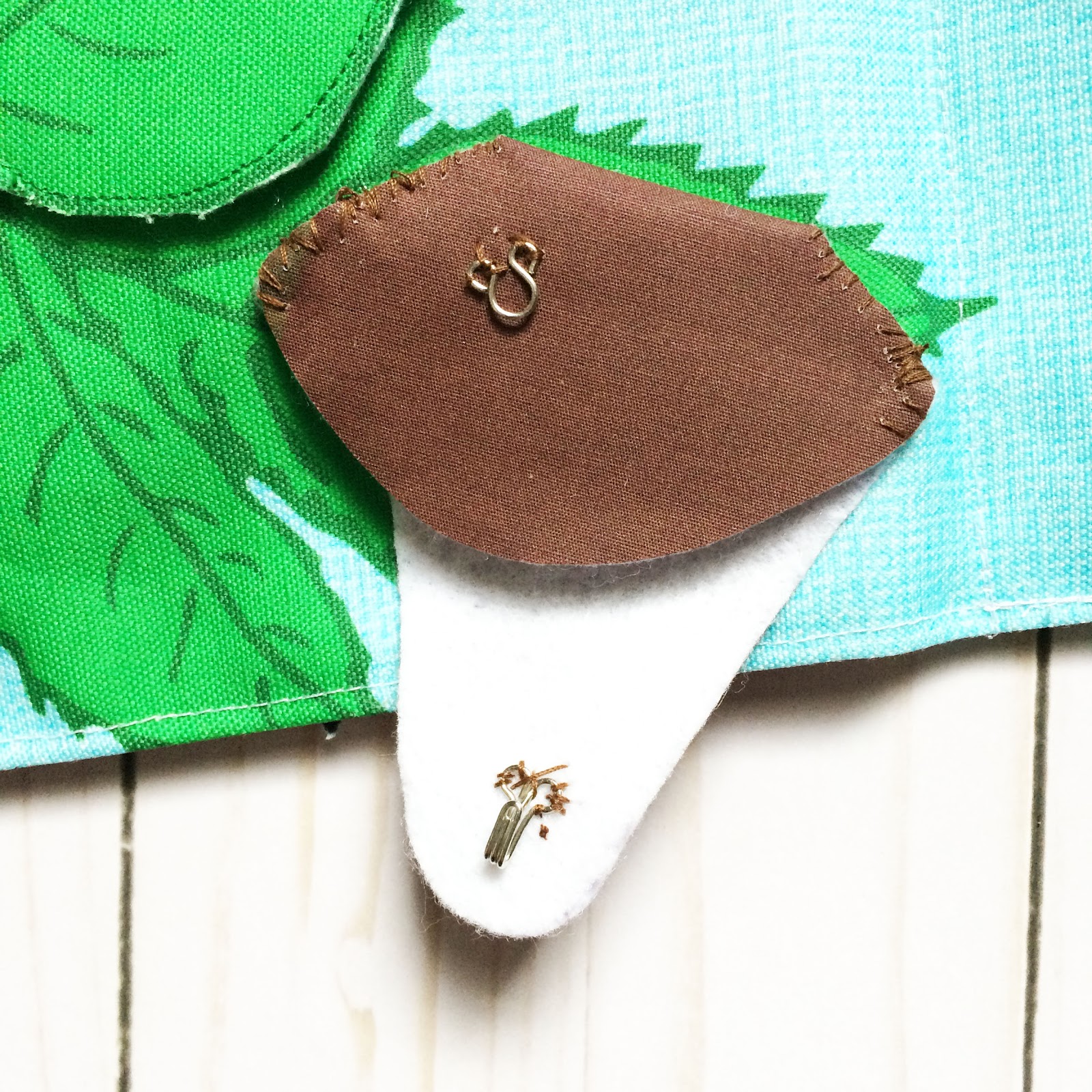 Take your hook and eyelet pieces and the brown “extra fabric” that will make up your cocoon.
Take your hook and eyelet pieces and the brown “extra fabric” that will make up your cocoon.
Sew the hook on the narrow end of the cocoon piece, on the felt side (not printed side) with the hook part facing away from the rest of the cocoon.
Next fold your cocoon so that the two melon shaped sides of it overlap. Then fold the narrow piece you just sewed the hook onto over the other half of the folded cocoon. Note where your hook aligns on the top of the cocoon. Where it aligns sew the eyelet piece with the large, round circle part facing toward the hook like pictured to the right. 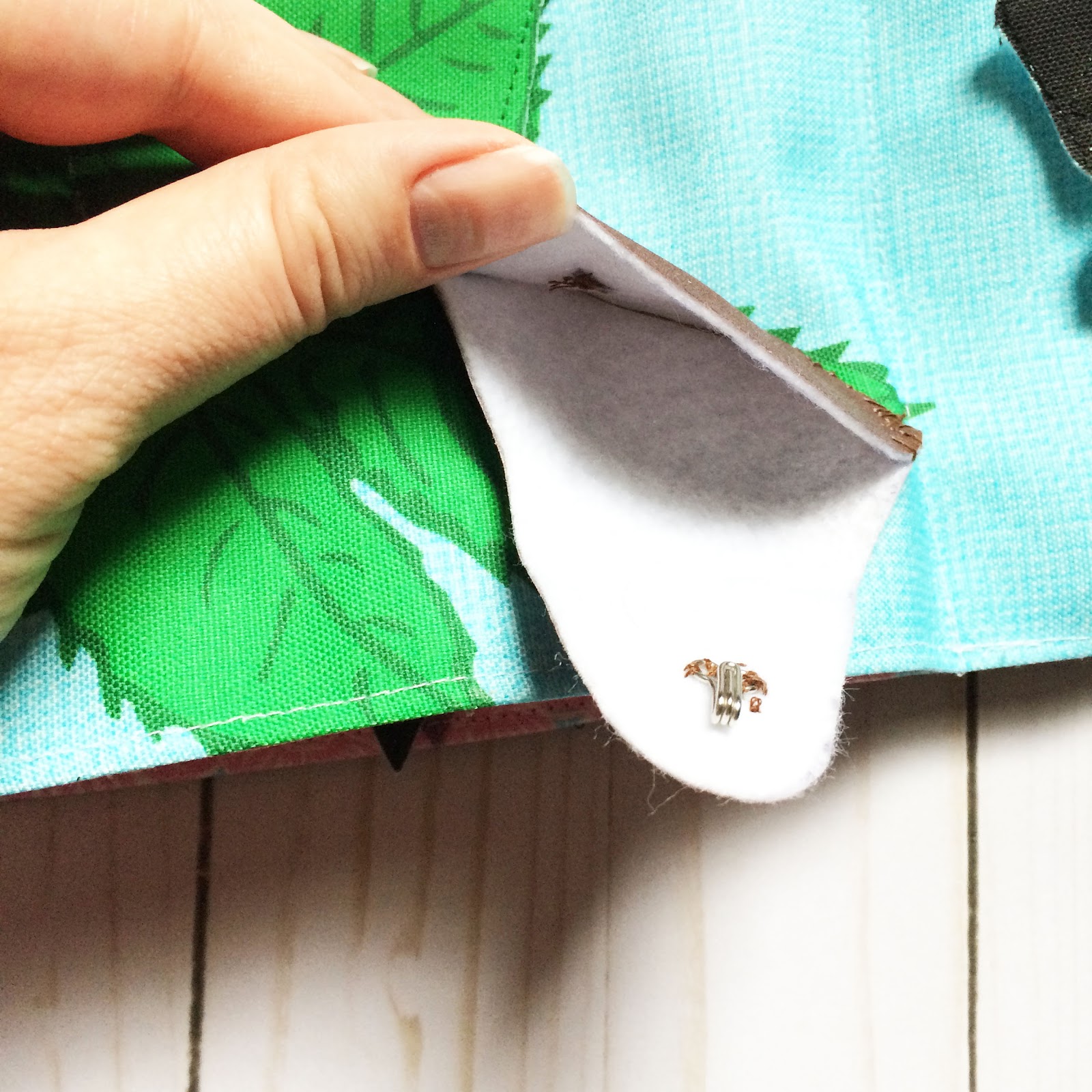
Step Sixteen:
Take the brown cocoon and again fold it so that the melon shaped sides overlap. While folded, pin it to the large green leaf of the page opposite the butterfly, and, starting at the pointed top part of the melon shape, sew around the cocoon from top point to bottom point only on the side without the flap. This should create a pocket to hold the caterpillar.
Step Seventeen:
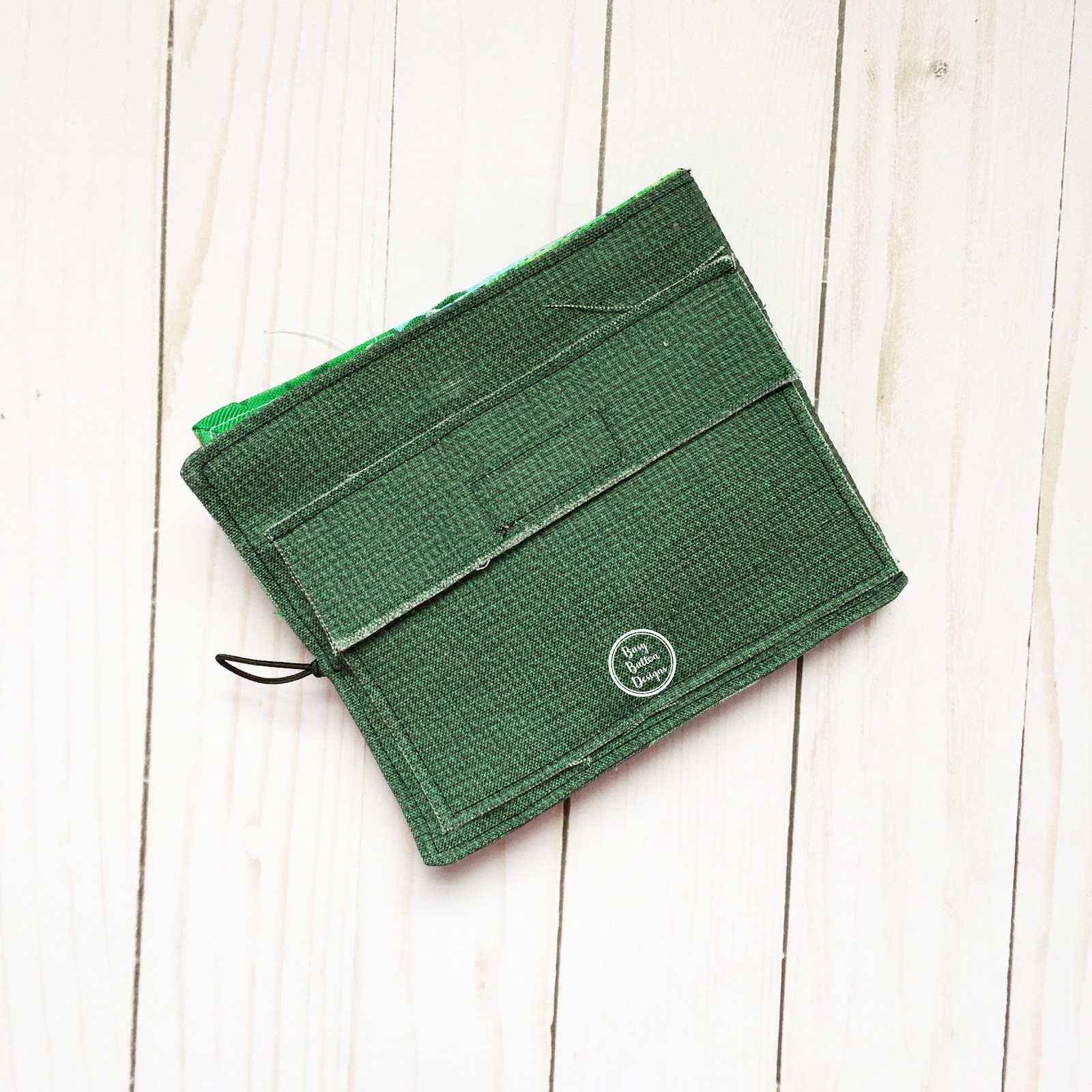 Find the two green rectangles of fabric (meant for a pocket on the back of the book). Take the green cover of the book and find the light outline of where the pocket should be. Line up the pocket pieces over the outline so you can see how the top and bottom part of the pocket will overlap. Take a square of Velcro and sew one part of it to the inside flap of the top pocket rectangle and sew the other part to the outside part of the bottom pocket rectangle so they can attach together when sewn onto the back cover.
Find the two green rectangles of fabric (meant for a pocket on the back of the book). Take the green cover of the book and find the light outline of where the pocket should be. Line up the pocket pieces over the outline so you can see how the top and bottom part of the pocket will overlap. Take a square of Velcro and sew one part of it to the inside flap of the top pocket rectangle and sew the other part to the outside part of the bottom pocket rectangle so they can attach together when sewn onto the back cover.
Then line up the larger of the pocket rectangles with the bottom outline on the cover page. Sew around the left, bottom, and right side of it. Afterward take the smaller of the rectangles (the lid) and line it up with the outline, pin in place, and sew only across the top of this piece. This should allow it to flap over the pocket and prevent any extra pieces from sliding out while still allowing easy access to the content inside.
Step Eighteen: (Optional)
Take the front cover of the book and sew a button onto the far right side of the page in the middle.
On the opposite side of the page pin the small loop of elastic, with the loop facing the print on the page, and the edges of the elastic pinned at the edge of the page.
Step Nineteen:
Take the front cover of the book, and lay it face up, then take the page with the bee puzzle and the ant and lay it face down over the top page, so the printed side of each page is touching. (Make sure all the extra pieces have been removed.)
Pin in place. Starting at the bottom middle sew around the outside of the two pages, about a ⅜ inch from the edge, leave about a four inch gap in the bottom of the book from where you began your sewing to where you end it. 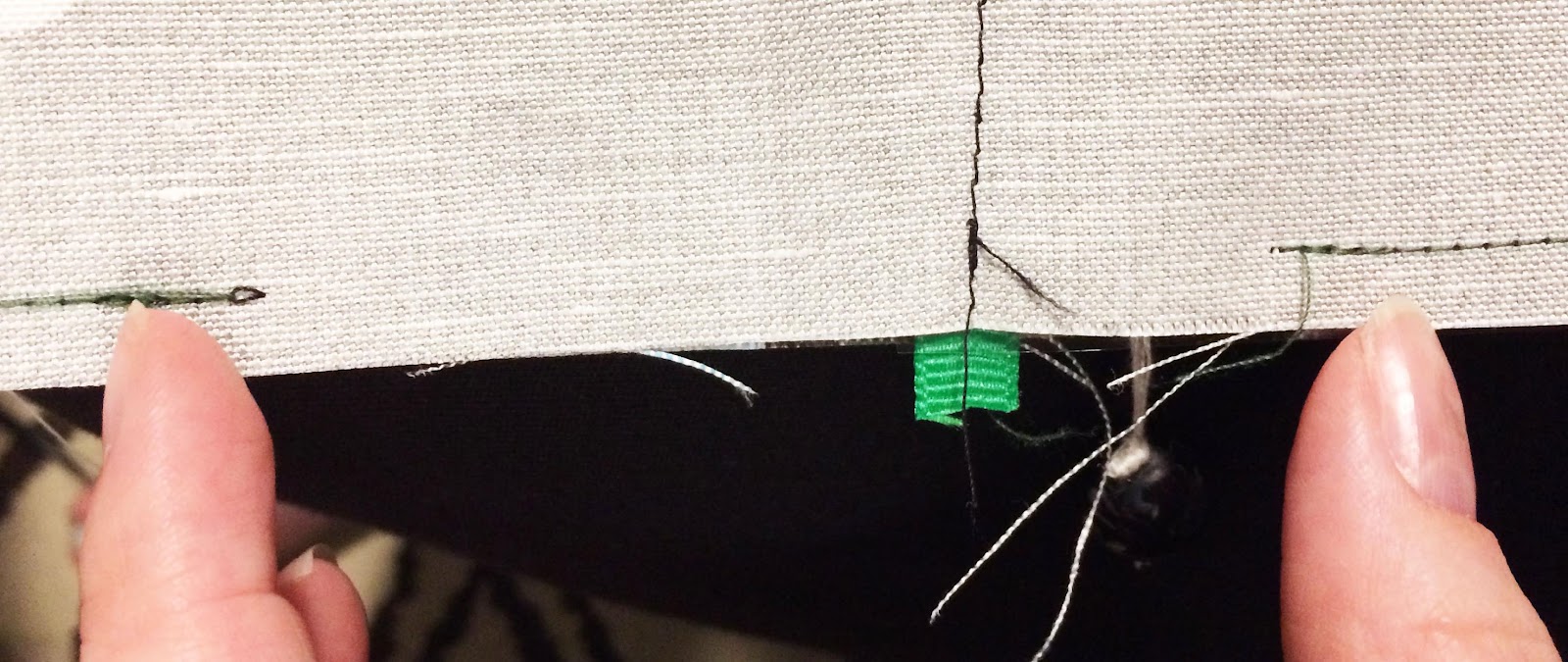
Also make sure your elastic loop is facing in against the printed pages and only the edges of it are at the seam.
Step Twenty:
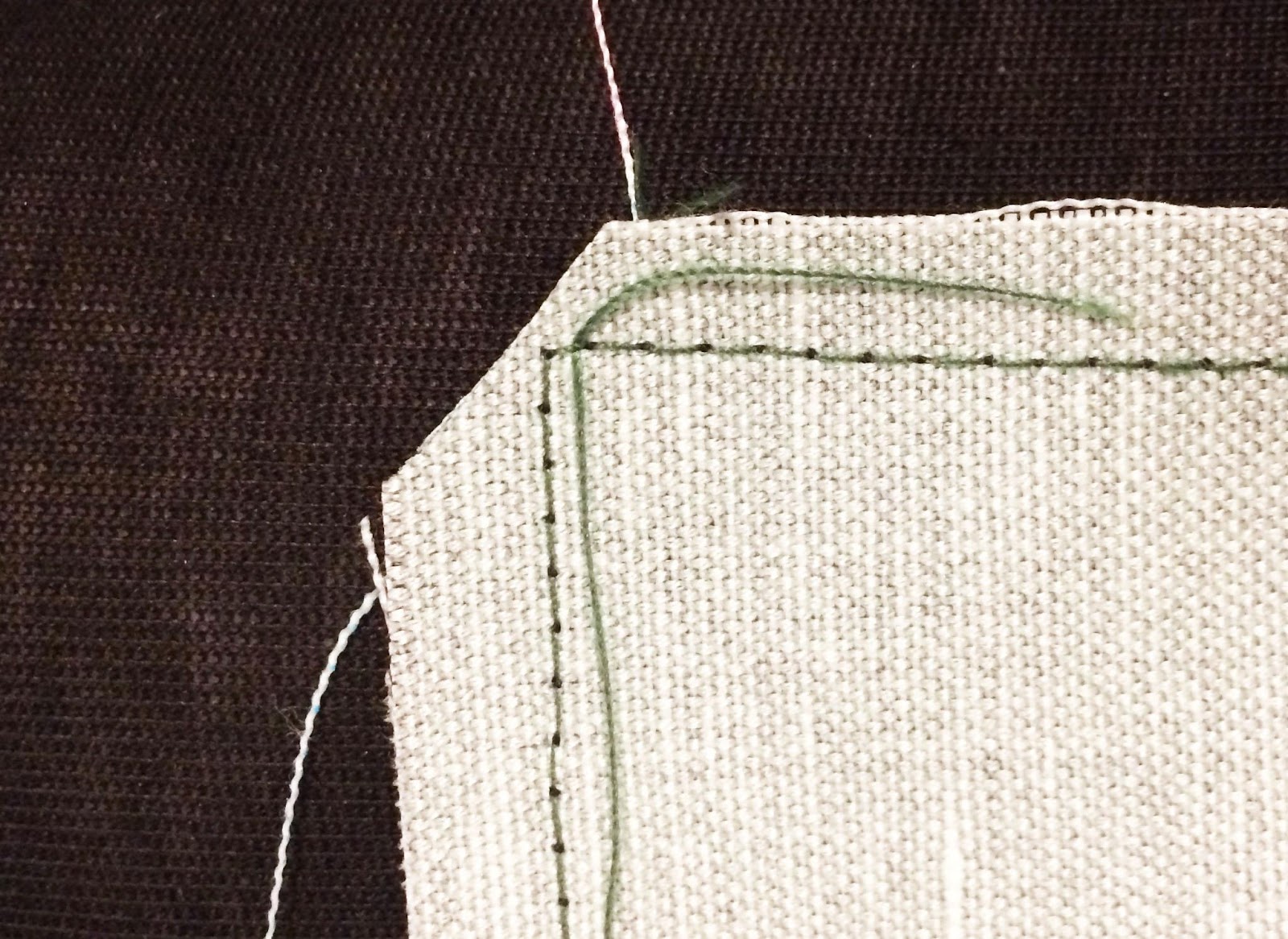 Clip off the extra fabric in the corners of your book (This will allow it to lay more flat when you flip the book).
Clip off the extra fabric in the corners of your book (This will allow it to lay more flat when you flip the book).
Step Twenty-One:
Use the four inch gap you left in step nineteen and flip the page, so that the print side is out, taking special care to press out the corners of the page as much as possible.
Iron your page flat. (Avoid ironing over the velcro as it will melt)
Step Twenty-Two:
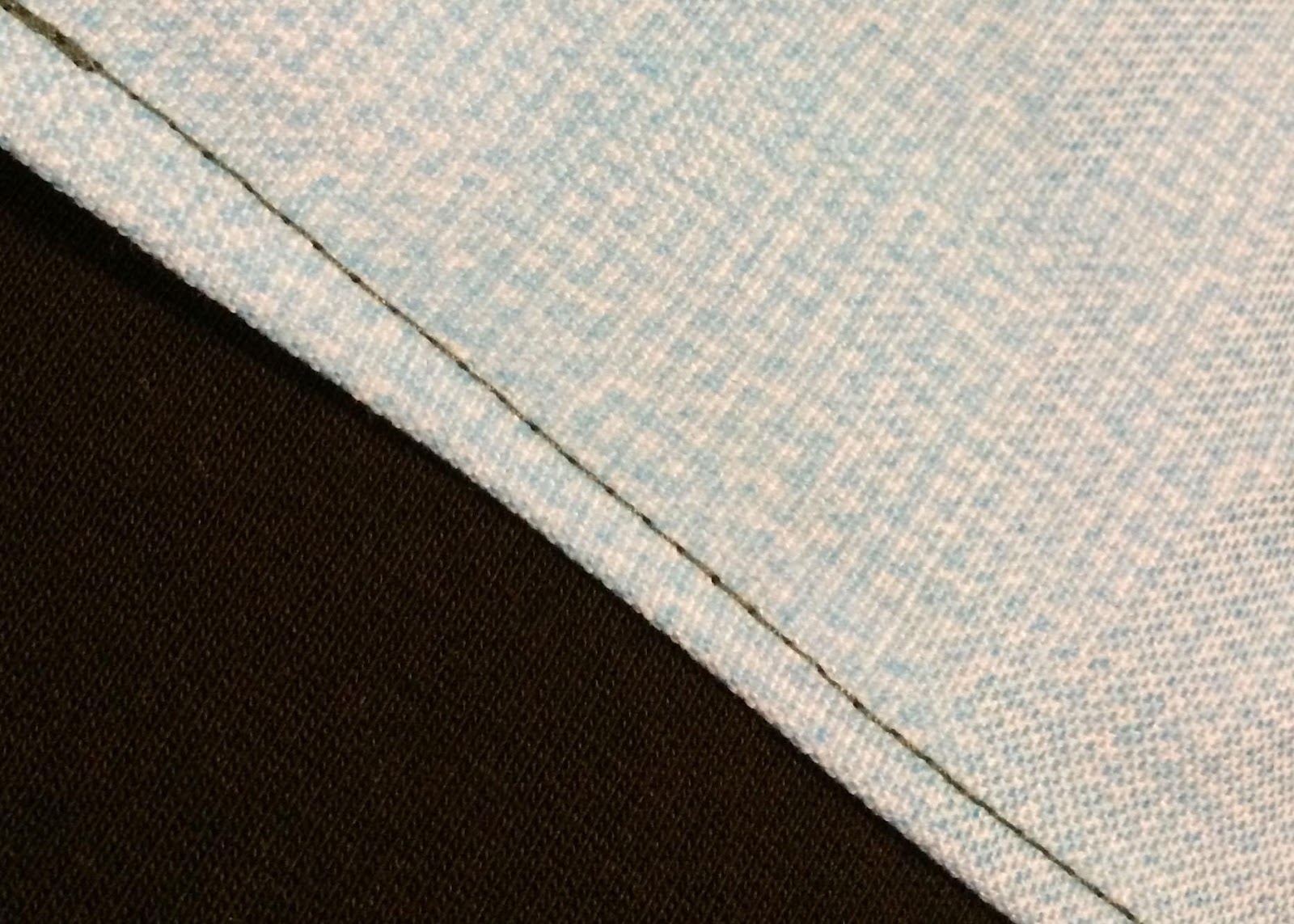 Fold up the edges of your four inch gap, and pin them in place. Then sew around the outside of your book page (about ¼ inch from the edge) Start and end your sewing in the same place so that your four inch gap is sealed shut.
Fold up the edges of your four inch gap, and pin them in place. Then sew around the outside of your book page (about ¼ inch from the edge) Start and end your sewing in the same place so that your four inch gap is sealed shut.
Step Twenty-Three:
Repeat steps Nineteen through Twenty-Two for the other two pages of your quiet book.
Make sure all of the string for the spider’s web is tucked into the book so it doesn’t get sewn into the pages as you attach them.
Step Twenty-Four:
Line up the two sewn rectangular pages (that create the whole of your quiet book) and pin them in place so they completely overlap one another. Sew a straight line down the middle of your overlapped pages, securing the pages of the book together like binding.
Step Twenty-Five:
Add all of your Busy Book pieces to the book, sliding any excess butterfly wings into the pocket on the back and congratulations, you are done! 🙂
Thank you so much for your purchase of this busy book fabric, if you found any of these instructions to be unclear or difficult please email me at [email protected] I’d love to get them updated and clarified to the best of my ability.
Spot cleaning with a light detergent and a damp rag is the best way to clean your quiet book, but it should also hold up if you remove all the excess pieces from it and wash it in the washing machine on a gentle cycle. Air dry only.
Please let me know if you have any comments or additional questions.
